

In choosing the right backpacking tent, you have a wide range of options from minimalist ultralight shelters to inexpensive and heavier entry-level models. Uses and budgets vary, and the ideal tent for beginners and those taking shorter trips differs significantly from thru-hikers counting every ounce. After extensive testing and many nights sleeping under the stars, we narrowed in on the best backpacking tents of 2025, selecting 18 standouts for everyone from first-timers to seasoned veterans. For ease of comparison, we’ve primarily listed two-person models here with other available capacities listed in the specs. For more background information, see our comparison table and buying advice below the picks, along with details about our testing process.
Editor's note: We updated this guide on May 30, 2025, to revise the details of our Durston X-Mid 2 review following some notable updates to the design. We also swept the guide to ensure all other information was up to date at the time of publishing.
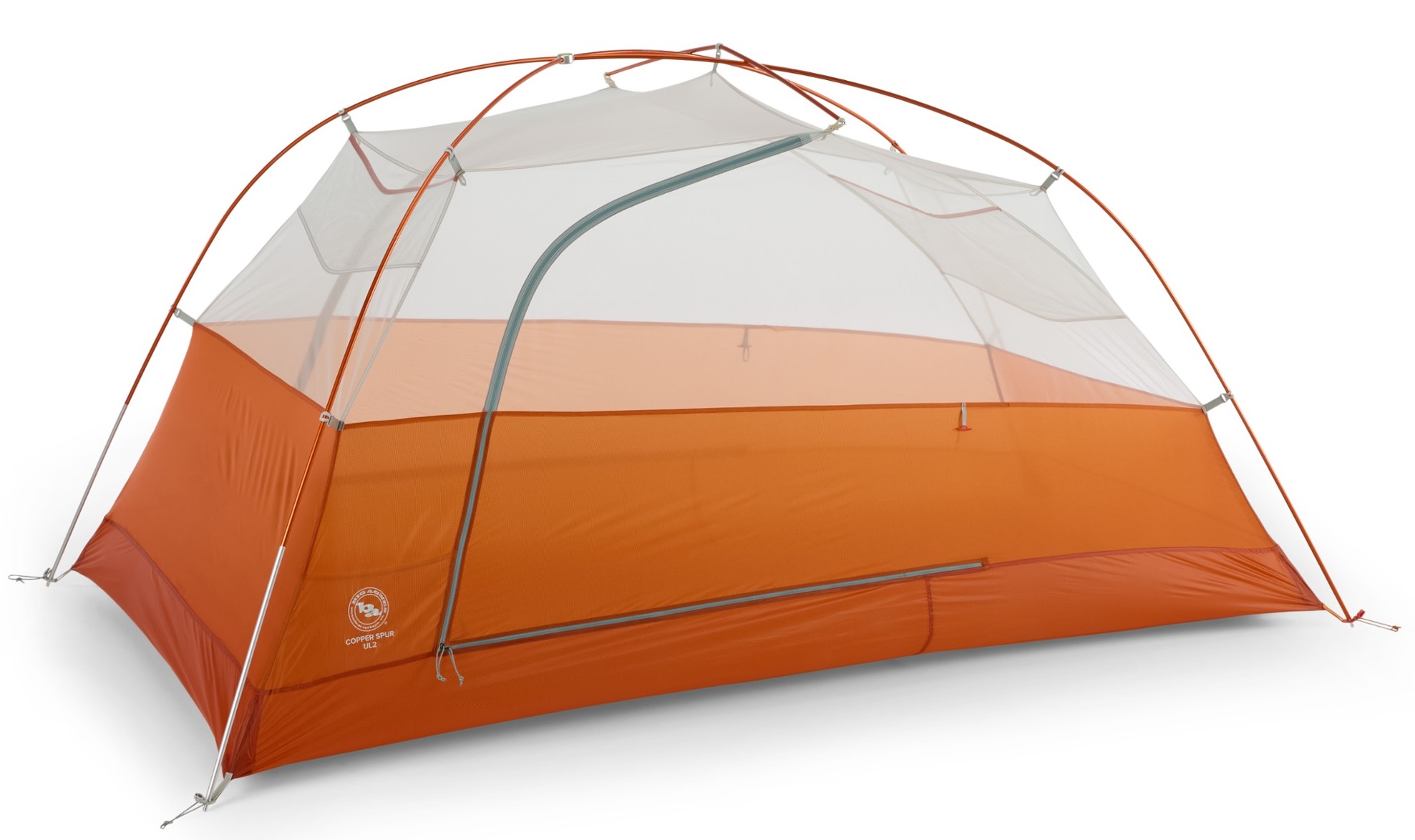 Category: All-around
Category: All-around
Packaged weight: 3 lb.
Floor dimensions: 88 x 52/42 in.
Capacities: 1P, 2P, 2+P, 3P, 3+P, 4P, 5P
What we like: Best-in-class combination of low weight, generous interior space, and ease of setup.
What we don’t: Pricey (even pricier than previous iteration) and thin materials require extra care.
For a backpacking tent that deftly balances weight, interior space, and features, look no further than the Big Agnes Copper Spur. This tent helped define the ultralight category and is still going strong many renditions later. In the latest two-person version, you get a healthy 29 square feet of floor space, solid headroom with pre-bent poles and steep walls, and two doors and vestibules—all at just 3 pounds. It’s much lighter than competitors like the Nemo Dagger below but has few compromises with a spacious and freestanding design. We’ve tested various iterations of the Copper Spur everywhere from Patagonia to Mongolia, and even East Africa, and it’s performed flawlessly in conditions ranging from warm nights to heavy rain and wind.
At $550, the Copper Spur UL2 is one of the pricier tents in its class, and you’ll want to be careful with the delicate materials (the 15 x 20D floor, in particular, is quite thin and won’t hold up to wear and tear as well as heavier models below). In addition, while the low weight is worth it for those who get out a lot, recreational backpackers may be better off with a heavier yet more durable design. Nevertheless, the Copper Spur’s quality is impeccable, with substantial zippers, thoughtful interior storage, color-coded grommets, and easy adjustments to really dial in your setup. And for bikers, Big Agnes also makes the Copper Spur HV Bikepack in one-, two-, and three-person versions, which feature shortened poles and rugged compression sacks that attach to a bike frame in multiple configurations.
Read more: Copper Spur HV UL2 review
See the Big Agnes Copper Spur UL2
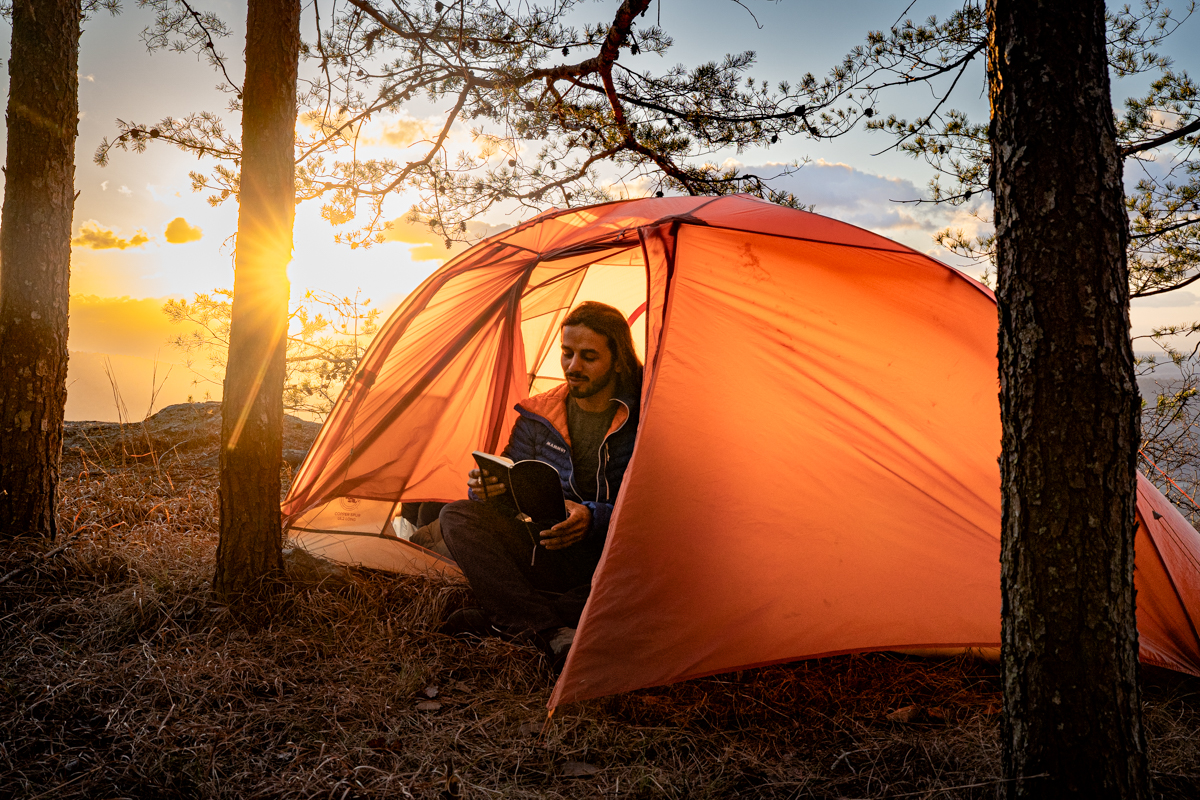
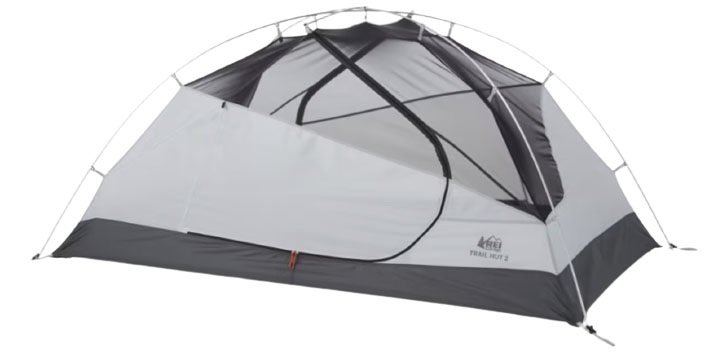 Category: Budget
Category: Budget
Packaged weight: 5 lb. 15.0 oz.
Floor dimensions: 88 x 52 in.
Capacities: 2P
What we like: Inexpensive, tough, and features a headroom-boosting ridge pole.
What we don’t: Not as modern-feeling or spacious as the Half Dome below.
Let’s be honest: A fair share of us are casual, fair-weather backpackers who make our way into the backcountry for just a weekend or two each summer. If this sounds like you, a budget pick like REI’s tried-and-true Trail Hut 2 is a great choice. For just $229, you get a durable tent (its 66D and 68D materials are much tougher than the lighter-weight options here) that features a door and vestibule on each side, full-coverage rainfly, and ridge pole for increased headroom. Throughout our testing (we even took the tent to southern Patagonia), we’ve been very impressed with its high-quality and confidence-inspiring feel. The around-$200 category is dwindling as inflation causes tent prices to rise, but the Trail Hut 2 continues to hold down the fort with a winning formula that few tents match.
What do you sacrifice by going with the REI Trail Hut? At almost 6 pounds (that includes the footprint), it will add significant weight and bulk to your pack, which is not ideal for those covering long distances over multiple days in the backcountry. In addition, you get standard aluminum rather than DAC poles, which are generally less premium and don’t come pre-bent like many high-end designs (this helps to boost interior space). But we can’t help but love the low price of REI’s budget model, which makes it a great pick for shorter trips and most casual backpackers. It’s also worth mentioning REI’s even cheaper Trailmade 2 ($199), but its quality and livability are noticeably more compromised for a mere $30 savings.
Read more: REI Co-op Trail Hut 2 review
See the REI Co-op Trail Hut 2
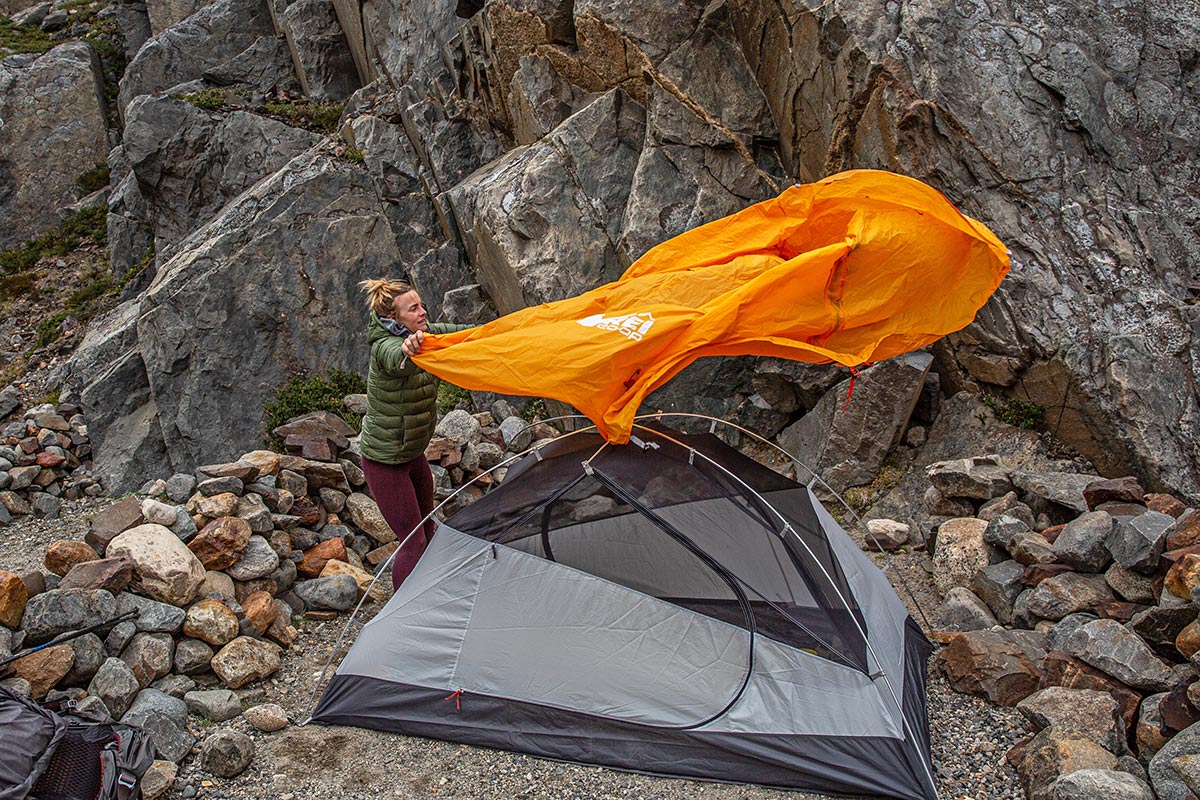
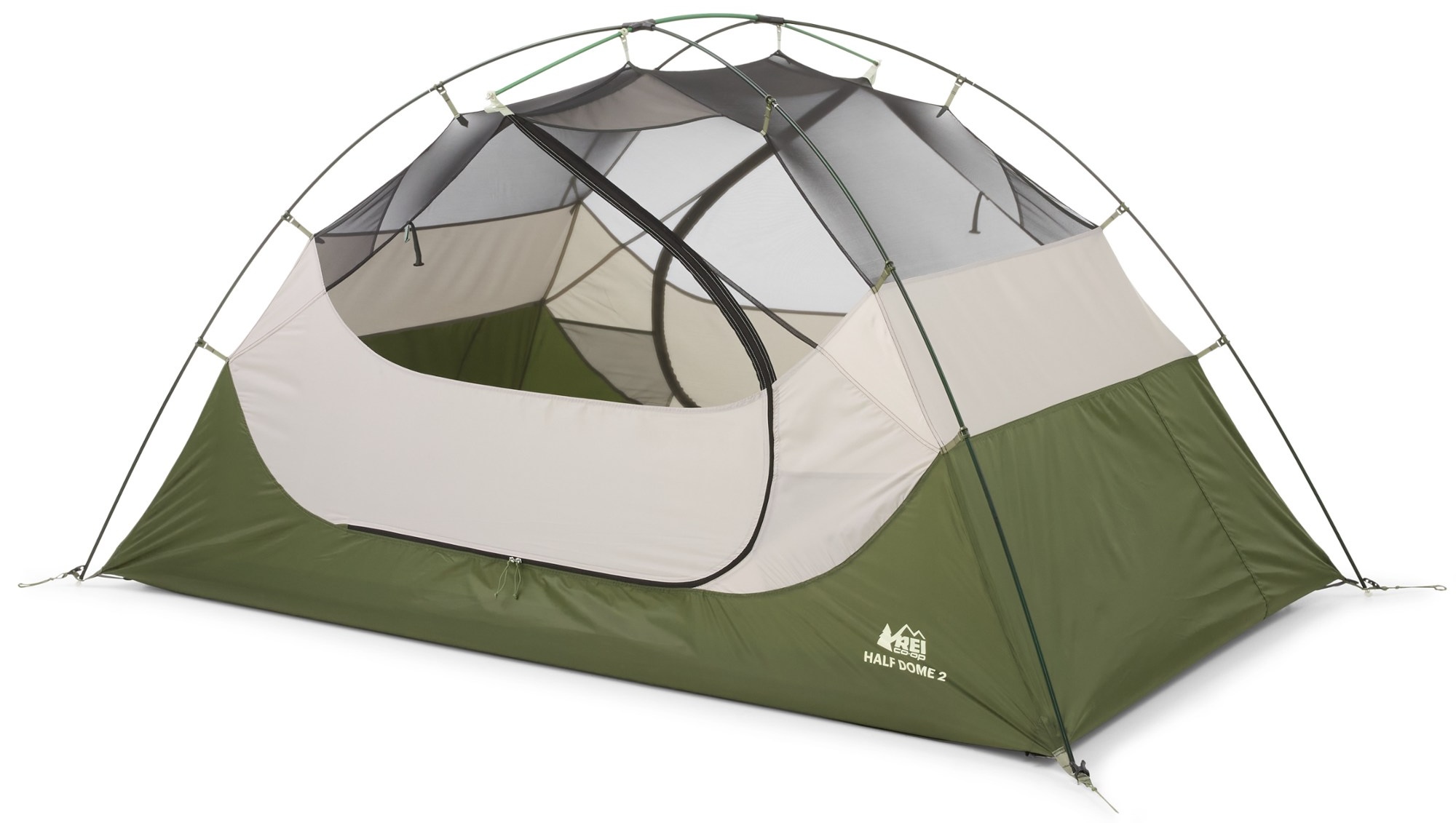 Category: All-around/budget
Category: All-around/budget
Packaged weight: 5 lbs. 15.1 oz.
Floor dimensions: 88 x 52 in.
Capacities: 2P, 2+P, 3P
What we like: A well-built tent with tons of room at a fantastic price.
What we don’t: Relatively heavy and bulky.
If you’re looking for the right combination of performance and price, it’s hard to beat REI’s iconic Half Dome. This tent has gone through multiple iterations over the years, and the most recent model is a great balanced offering with an updated pole structure to provide more shoulder and headroom. For $299, the Half Dome is well built, easy to set up and take down, relatively durable with a 75-denier floor (and a 40D rainfly, which is more durable than the prior version), and has ample mesh for stargazing and ventilation. Yes, you can save with the cheaper REI Trail Hut above, but there are some trade-offs in terms of interior space, weight, and packed size. All told, we think the Half Dome is a great value for what you get and should keep many backpackers happy—it’s the tent we most often recommend to family and friends.
For $250 less than the top-rated Copper Spur, the Half Dome offers a bump in durability, and its generous dimensions make it a very roomy tent for two. But you can’t have it all, and in the case of this model, the big compromise comes in terms of weight and bulk. At over five pounds for the smallest 2-person version, it takes a hefty toll on your base weight, although you can drop about 8 ounces by leaving the included footprint behind (or share the weight with a partner). Despite the nitpicks, we think the Half Dome is in a class of its own among value options, making it a reasonable choice for seasoned backpackers on mild excursions and beginners just breaking into the scene alike. If you’re okay with a slight increase in weight and cost (6 lb. 3.6 oz. and $359), the Half Dome 2 Plus is a great alternative to consider that offers more interior space (92 x 56 in. interior).
Read more: REI Co-op Half Dome 2 Plus review
See the REI Co-op Half Dome 2
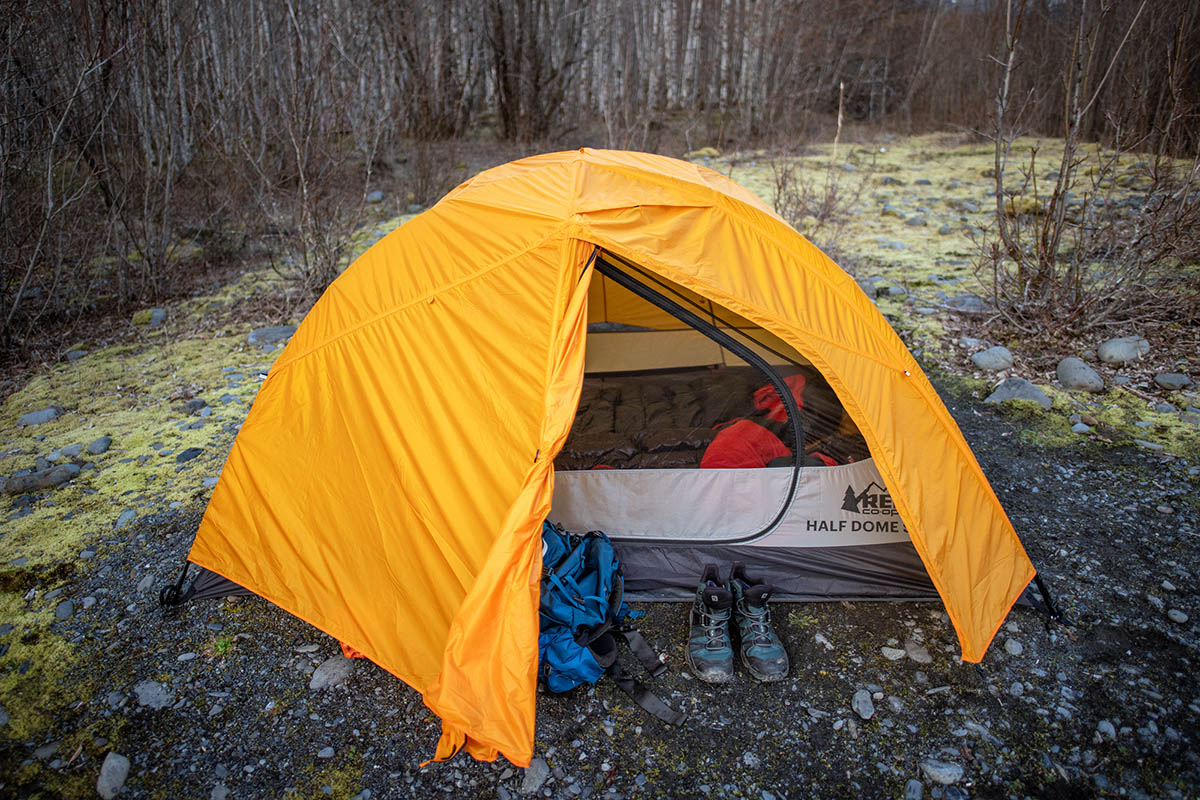
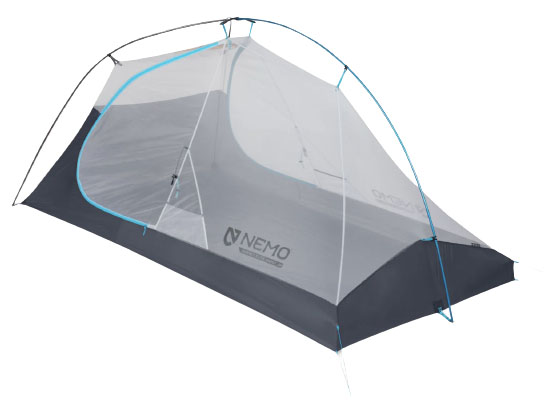 Category: Ultralight
Category: Ultralight
Packaged weight: 2 lb. 1.0 oz.
Floor dimensions: 85 x 50/42 in.
Capacities: 1P, 2P
What we like: Incredibly lightweight without sacrificing the two-door, two-vestibule design.
What we don’t: Thin fabric requires extra care; floor plan is very tight for two.
Ultralight tents can get pretty specialized, with some high-end, trekking pole-supported shelters dipping as low as just over a pound. But for those coming from a traditional backpacking background, we prefer an option like Nemo’s Hornet Elite Osmo 2P. While not the lightest tent here at 2 pounds 1 ounce all in, it’s a very approachable option: The Hornet Elite is easy to set up with an intuitive semi-freestanding design and color-coded components, well built with quality materials that—while thin—have held up well throughout extensive testing, and more reliable in strong winds and wet weather than many similarly light competitors. Ounce for ounce, the Hornet Elite is one of the most livable and premium options in its weight class, making it a great choice for everyone from serious thru-hikers to those just dipping their toes in the UL space.
However, while the Hornet Elite is arguably the best semi-freestanding tent on the market, its ultralight build still has a host of limitations. Nemo doesn’t list a thickness for the fabric, but we’d place it around 10-denier for the fly and floor, which is undeniably thin. Further, while Nemo managed to retain a two-door-and-vestibule layout, the Hornet Elite’s tapered and streamlined floor plan is a very snug place for two. But if you choose your campsites wisely (don’t pitch the Hornet Elite on top of sharp rocks or sticks) and aren’t opposed to cozying up with your tentmate, the Nemo is a remarkable 2-pound shelter. For those who aren’t deterred by a more complex setup, Zpacks’ trekking pole-supported Duplex below checks in at a remarkable 1 pound 4.4 ounces and features a roomier interior, but it’s a steeper investment at $729 and decidedly more specialized than the Nemo.
Read more: Nemo Hornet Elite Osmo 2P review
See the Nemo Hornet Elite Osmo 2P
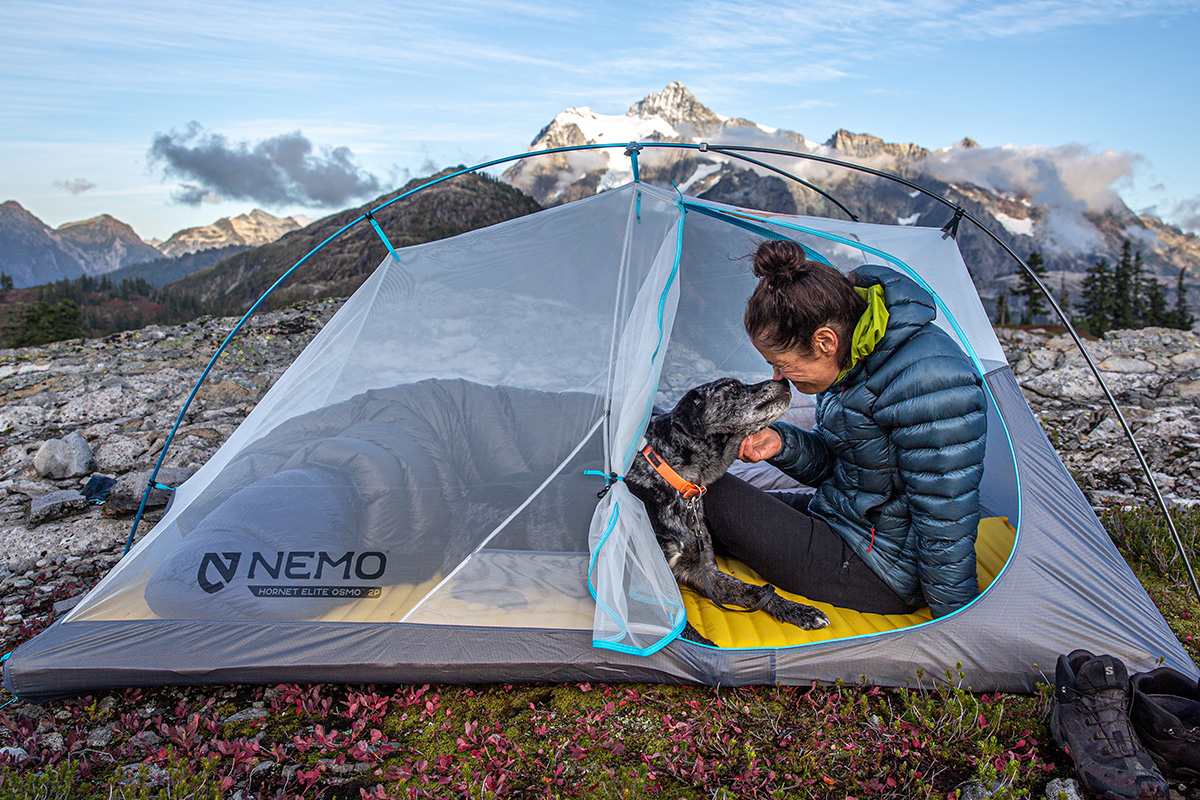
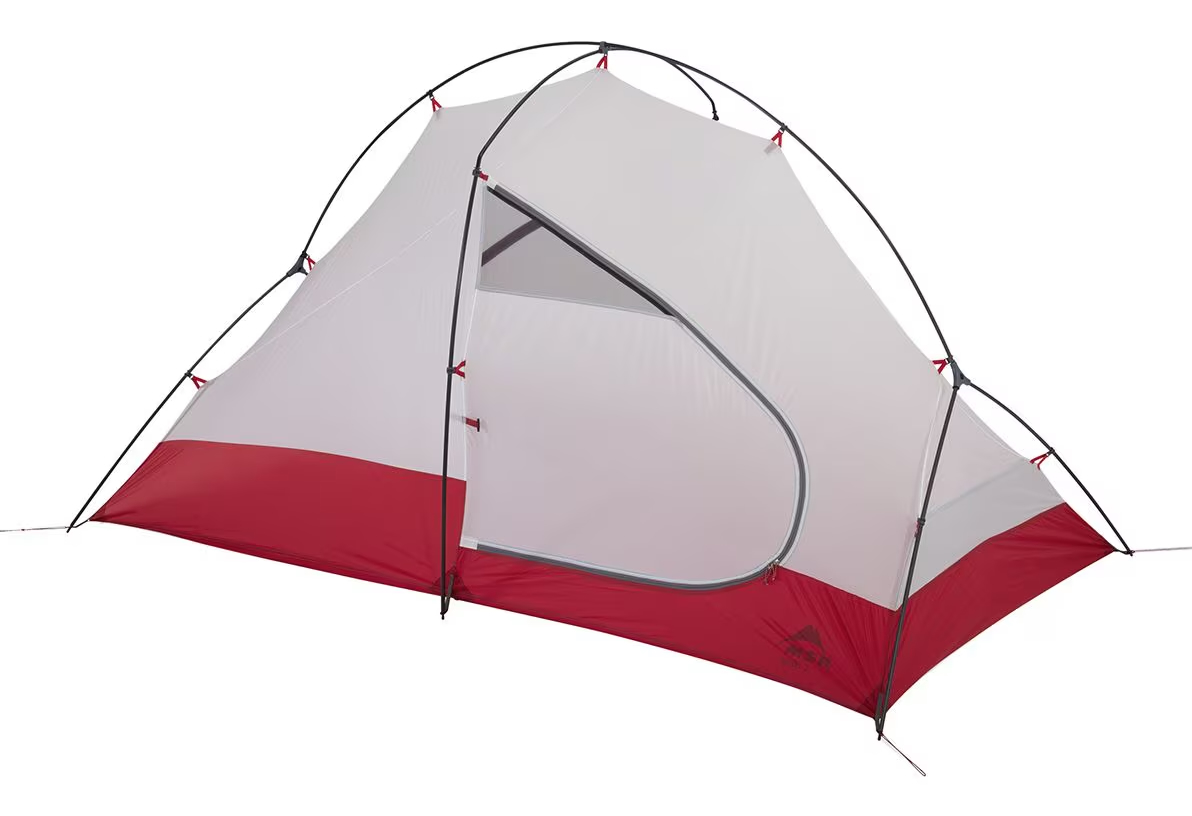 Category: All-season
Category: All-season
Packaged weight: 4 lb. 1.0 oz.
Floor dimensions: 84 x 50 in.
Capacities: 1P, 2P, 3P
What we like: Lightweight yet much burlier than a standard 3-season tent.
What we don’t: Expensive; solid walls impact breathability in mild conditions.
The majority of backpacking tents are of the lightweight, 3-season variety, but if you anticipate getting out in tougher conditions, you may want to step up your protection. Slotting just below a full-on winter-ready design is MSR’s Access 2. With a sturdy structure, durable poles, and considerably less mesh than its warmer-weather counterparts, the Access is built to handle driving wind, rain, and snow. Importantly, you still get two doors and vestibules and a decently roomy, non-tapered floor area for just 4 pounds 1 ounce, which is a truly impressive feat. For backcountry ski trips or spring mountaineering when you need a step up from a standard backpacking tent, the Access is well worth a closer look.
Our biggest gripe with the Access is that it’s not particularly versatile for mild conditions—with very little mesh in the tent body, it’ll overheat quickly unless you’re mindful to keep doors and vents open at night. And at $800, it’s undeniably spendy. In terms of other tents that fit a similar designation, the Hilleberg Nallo below is an impressively tough option (compare its 70D floor to the MSR’s 30D) but offers less interior space, is less breathable due to its thicker materials, and is over a pound heavier than the Access at 5 pounds 5 ounces. Additionally, Big Agnes makes a beefed-up Expedition version of its popular Copper Spur, and we’ve had good luck with the Nemo Kunai over the years. These are all worthy tents for intrepid backpackers headed out year-round, but the Access strikes a particularly nice balance of weight, price, and performance.
Read more: MSR Access 2 review
See the MSR Access 2
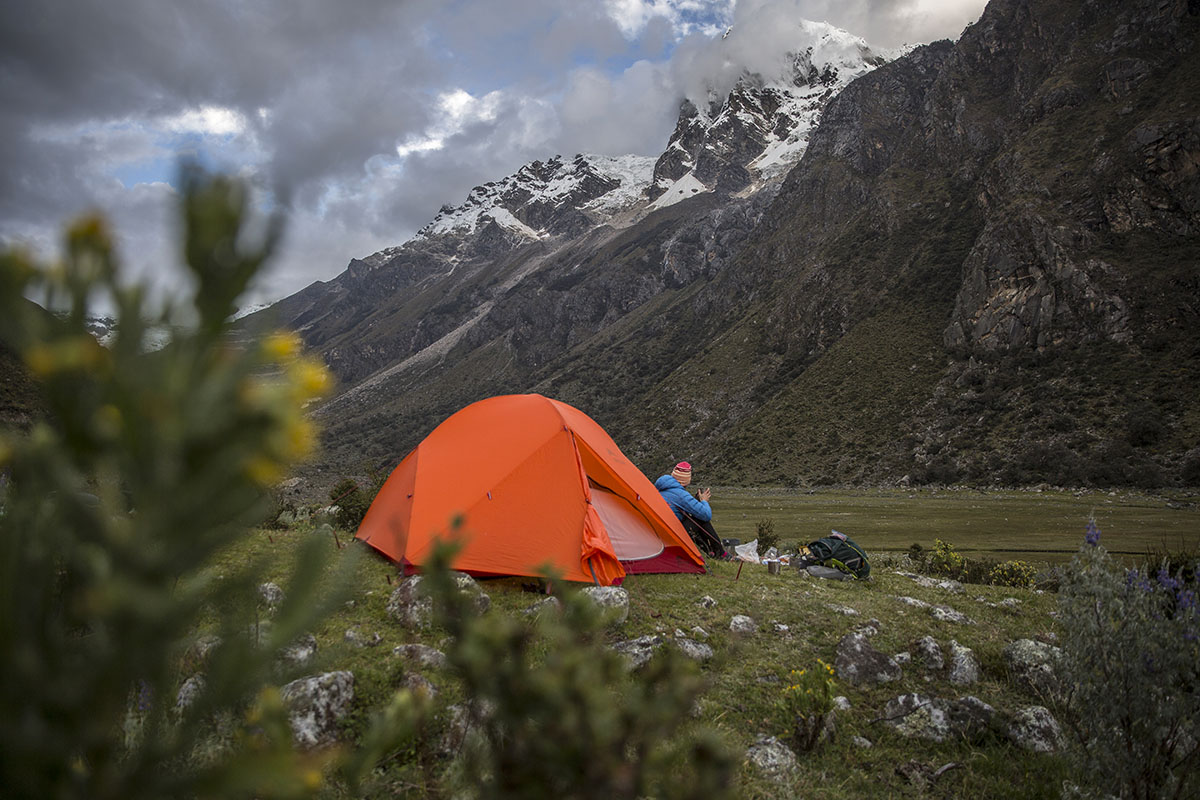
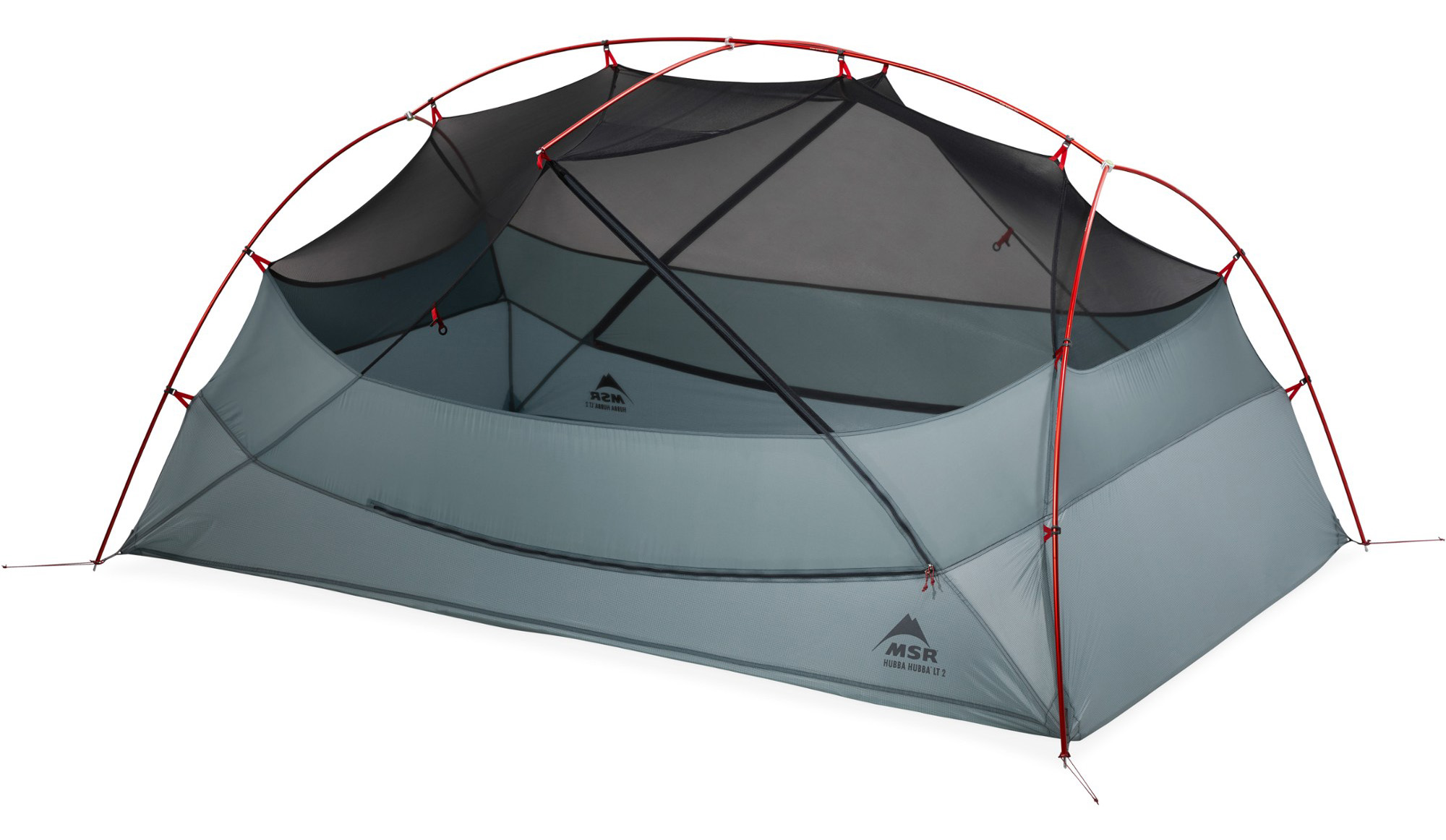 Category: All-around
Category: All-around
Packaged weight: 3 lb. 6.0 oz.
Floor dimensions: 88 x 52 in.
Capacities: 1P, 2P, 3P
What we like: Highly livable and well built with a recent upgrade in ventilation.
What we don’t: Slightly heavier and less weather-worthy than the past model.
MSR’s Hubba Hubba has been a mainstay on this list for years, and they recently released a fresh take on the design. Rebranded as the Hubba Hubba LT, the latest tent retains a lot of what we loved about the prior version, including a non-tapered floor plan that was made both longer (by 4 in.) and wider (by 2 in.), a 40-inch peak height, and near-vertical walls that offer excellent interior space. Weight-wise, the LT is 2 ounces heavier than the past-generation model, but it’s still competitive with the likes of the Big Agnes Copper Spur above (3 lb. 2 oz.) while significantly undercutting Nemo’s similarly roomy Dagger below (4 lb. 2 oz.). And build quality remains a hallmark of the design, including easy-to-trust DAC poles, functional interior storage, and thin (20D) but reliable fabrics.
One area we’re concerned about with the latest Hubba Hubba LT is weather resistance. While the past model was an above-average performer in this category, the LT uses significantly more mesh in the design, which is great for airflow but detracts from wind protection (and warmth if you get out well into the shoulder seasons). Its rainfly also leaves a bit more of the tent body exposed at the base, although the bathtub floor is high enough to bridge the gap. We have yet to test the latest Hubba Hubba LT, but initial reviews are promising, and there are enough similarities between the past and current models that we’re expecting comparable all-around performance.
See the MSR Hubba Hubba LT 2P
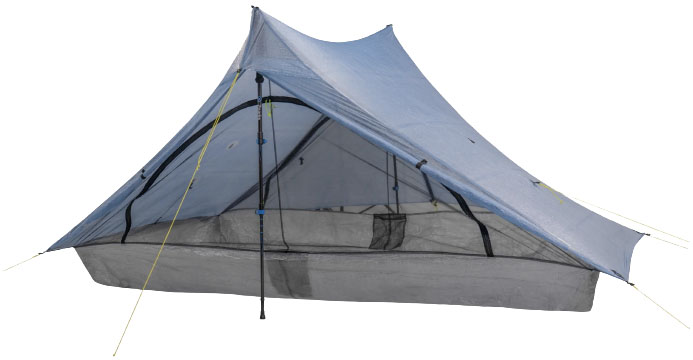 Category: Ultralight
Category: Ultralight
Packaged weight: 1 lb. 4.4 oz. (trekking pole-supported)
Floor dimensions: 90 x 45 in.
Capacities: 2P, 2+P, 3P
What we like: Extraordinarily light yet roomy and durable; Dyneema doesn't sag and won't ever lose its waterproof properties.
What we don’t: Mesh-heavy design is vulnerable to high winds; lacks the high-end feel of the Hyperlite Unbound 2.
A number of leading ultralight tents use Dyneema—the high-tech fabric praised for its hydrophobic nature, sag resistance, and stellar strength-to-weight ratio—and the trekking-pole-supported Zpacks Duplex Zip is a classic and time-tested design. With an incredibly low weight of just 1 pound 4.4 ounces (excluding stakes), it’s by far the lightest tent here but offers a surprisingly roomy sleeping area for two and includes a bathtub floor for a true tent-like feel. In use, we found the Zpacks to be surprisingly user-friendly and weather-protective, roughly on par with ultralight semi-freestanding tents that check in a full pound heavier. And the latest “Zip” version builds off the original Duplex, with modernized features like zippered storm doors, peak vents, and magnetic doorkeepers. In the end, no tent is perfect, but the Duplex Zip feels surprisingly complete for such a feathery design.
Within this category, we’d be remiss not to also mention the Hyperlite Unbound 2 ($699). The Unbound closely follows the design of the Duplex Zip but with a noticeably higher-end look and feel. It features a stellar build quality (the cottage-brand Duplex feels ever so slightly handmade), a sleek buckle at the base of the door that can be operated with one hand, and contrasting colorways and components. However, the Unbound is 3.6 ounces heavier, uses a thinner floor fabric, and lacks the Duplex’s end cinches that close the mesh gap between the canopy and bathtub floor, which can make a difference in high winds or heavy rain. In the end, neither tent is our first choice for exposed campsites or inclement weather (largely due to the mesh-heavy design), and your final decision will come down to priorities: Do you want the durability and low weight of the Duplex Zip, or the premium finishes of the Unbound?.
Read more: Zpacks Duplex Zip review
See the Zpacks Duplex Zip
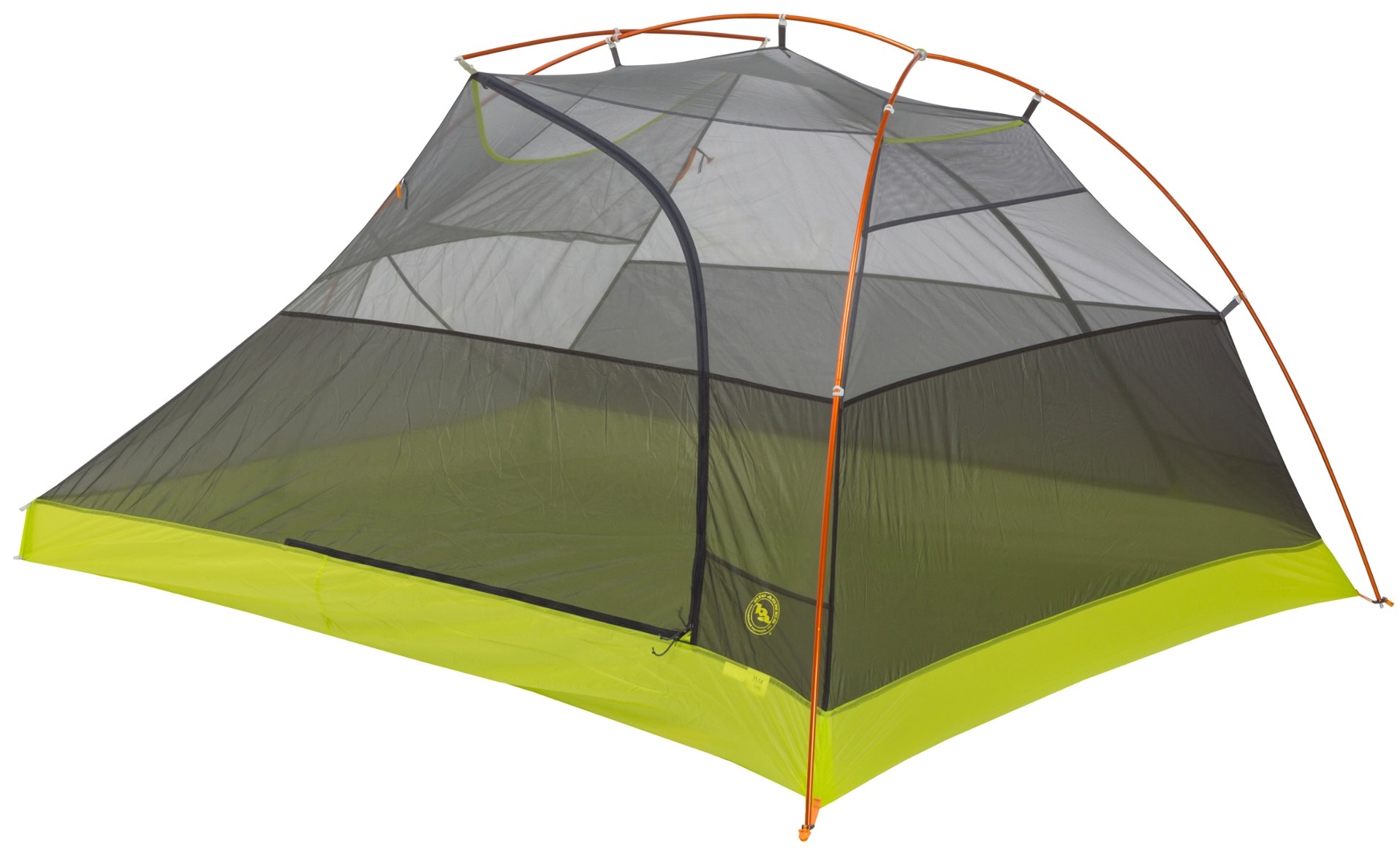 Category: Ultralight
Category: Ultralight
Packaged weight: 3 lb.
Floor dimensions: 88 x 66/60 in.
Capacities: 1P, 2P, 3P
What we like: Lightweight yet still roomy.
What we don’t: Semi-freestanding design is a bit more difficult to pitch.
If you’re traveling as a pair, a two-person tent is your best bet for streamlining weight and bulk. But if you’ve ever been tent-bound in a storm before, you know: The walls can start closing in quickly. The good news is that with advancements in fabric technology and tent design, it’s possible to bump up to a more spacious shelter without dramatically increasing your load. Big Agnes’ Tiger Wall UL3 is one of our favorite three-person tents thanks to its low weight—for right at 3 pounds, it’s a very roomy shelter for two, with space still left over for a child, a canine, or gear. If you’re traveling in inclement weather, with a smaller third companion, or just like the idea of some extra room (without a crazy weight penalty), it’s as good an option as any.
The Tiger Wall keeps weight down with a semi-freestanding design, which does come with some disadvantages. We’ve found it particularly difficult to get a taut pitch when camping on rock, and the tent simply isn’t as weather-worthy as a freestanding design like the Copper Spur above. But you do get two doors and two vestibules, and a large ridge pole across the center offers a great boost in headroom. In terms of materials, the Tiger Wall’s silicone-coated nylon is impressively strong (although it’s still thin and requires gentle treatment), and we like that Big Agnes has turned to fade-resistant solution-dyed fabrics in order to reduce their environmental footprint. Finally, keep in mind that you can shave even more weight by opting for the Tiger Wall 3 Platinum ($700; 2 lb. 11 oz. ) or Tiger Wall 3 Carbon ($2,000; 1 lb. 13 oz.), which are largely similar but use lighter materials.
Read more: Big Agnes Tiger Wall UL2 review (bikepack version)
See the Big Agnes Tiger Wall UL3
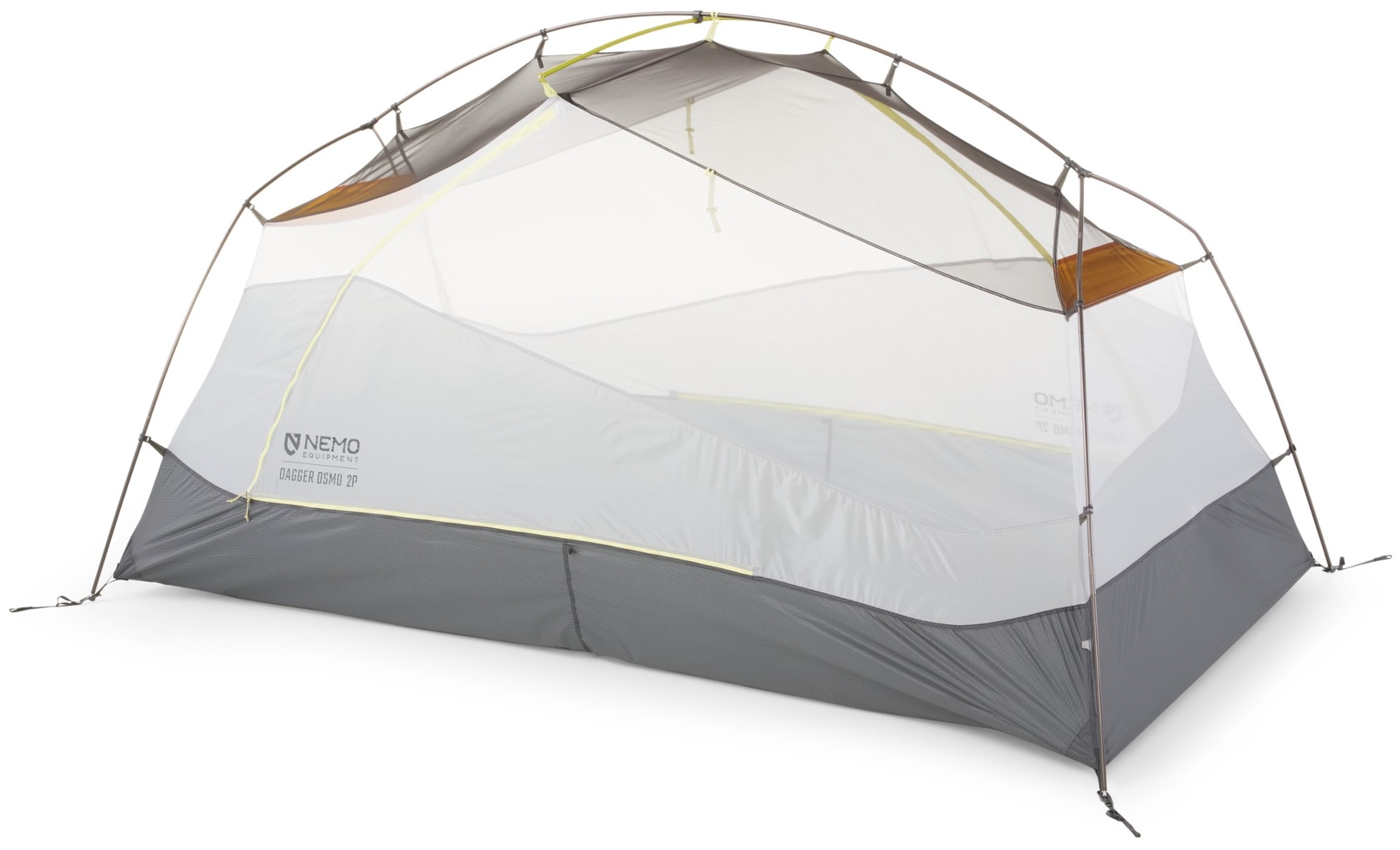 Category: All-around
Category: All-around
Packaged weight: 3 lb. 15 oz.
Floor dimensions: 88 x 50 in.
Capacities: 2P, 3P
What we like: Roomier than most two-person backpacking tents and easy to set up.
What we don’t: Relatively heavy; ventilation and weather protection could be a little better.
For weight-conscious backpackers who don’t want to compromise on livability and durability, the Nemo Dagger Osmo is a proven option. At 3 pounds 15 ounces for the two-person version, this tent is roomy, reasonably lightweight and durable, and packed with features. You get two large doors, two spacious vestibules for storing gear, and a generous interior that’s a few inches longer than most of the competition. Finally, the floor of the Dagger Osmo is symmetrical as opposed to tapered toward the feet, making it possible for two people to sleep in opposite directions (head to toe) for more shoulder room.
The big news with the latest Dagger is the use of Nemo’s Osmo fabric, which is intended to boost water resistance and reduce sagging, all while eliminating the use of harmful chemicals in production. It’s a great win for weather protection and sustainability, but with a bit of a weight increase, the Dagger Osmo is heavier than tents like the Copper Spur (3 lb.) and Hubba Hubba LT (3 lb. 6 oz.). Further, its design falls short in a few other ways: The small openings at the doors don’t dump condensation as well as the MSR’s large vents at each end, and the fly doesn’t extend all the way to the ground at the head and foot. But the Dagger Osmo is unparalleled in terms of interior space, making it especially well suited for taller hikers or those who want a bit more room. For a lighter (3 lb. 8 oz.) and cheaper ($400) option from Nemo, their Mayfly Osmo 2P offers an excellent balance of weight and durability but is a notably tighter fit for two.
Read more: Nemo Dagger Osmo 2P review
See the Nemo Dagger Osmo 2P
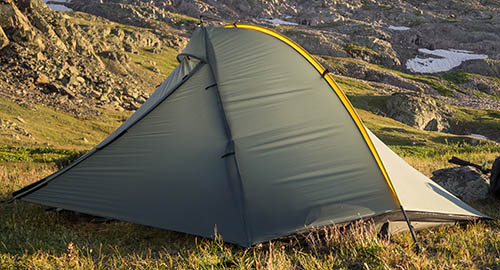
Category: Ultralight
Packaged weight: 2 lb. 10.0 oz.
Floor dimensions: 88 x 50 in.
Capacities: 1P, 2P, 3P
What we like: A fairly uncompromised design that’s still affordable and lightweight.
What we don’t: Not freestanding and seam sealing costs extra.
California-based cottage brand Tarptent isn’t a household name yet, but the company offers an inspiring ultralight lineup at reasonable price points. The Double Rainbow is our favorite model, featuring a unique single-wall design that keeps weight in check while still maintaining impressive livability. For just 2 pounds 10 ounces, you get a 30-denier floor (15D is standard in UL tents), a generous and symmetrical floor plan that easily fits two sleepers (30.6 sq. ft. compared to the Tiger Wall’s 28 sq. ft.), and two doors and vestibules. Priced at just $349 with aluminum poles ($379 with upgraded carbon fiber poles), it’s no wonder that the Double Rainbow is one of the most popular cottage designs among ultralighters and thru-hikers this year.
The Tarptent’s hybrid single-wall construction means setup is a breeze: You simply thread the main pole through a sleeve in the rainfly and stake everything out (the “tent body” is made of mesh and hangs from the bottom of the rainfly). This is particularly nice in wet conditions, as there’s no moment during the setup process when the inside of the tent is exposed to rain. It’s important to keep in mind that the Double Rainbow is a non-freestanding design, which means you’ll need soft ground or good anchors to get a good pitch (alternatively, you can convert it to freestanding with trekking poles). Finally, it does not come seam-sealed, but it’s a fairly simple DIY process, or you can add it onto your order for $35. And a final note: Tarptent also makes the Double Rainbow Li ($799), a Dyneema version that competes more closely with the Zpacks Duplex Zip above.
Read more: Tarptent Double Rainbow review
See the Tarptent Double Rainbow
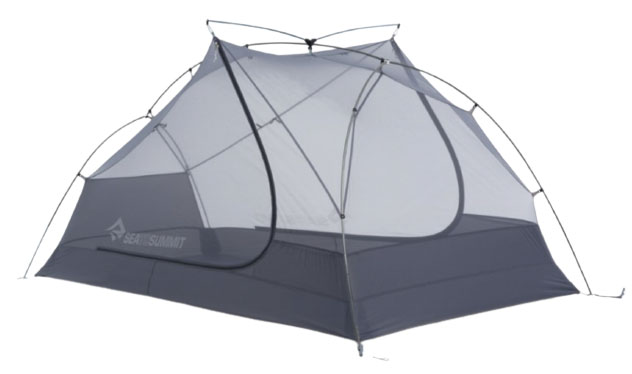 Category: All-around
Category: All-around
Packaged weight: 3 lb. 10.7 oz.
Floor dimensions: 84 x 53/43 in.
Capacities: 2P, 3P
What we like: Tension Ridge maximizes livable space and ventilation.
What we don’t: Water can pool in the fly’s concavities and drip in through the vents.
Australia-based Sea to Summit is a reliable go-to for outdoor gear, but 2021 marked their first foray into backpacking tents. And they entered the competitive market with a bang, unveiling two models: the semi-freestanding Alto TR and the all-around Telos TR featured here (a newer, more budget-friendly Ikos TR was also released). The headliner is the unique Tension Ridge, which gently bends the ridge pole upward at each end rather than the more common downward-sloping design (concave vs. convex). It’s a small tweak in construction with a significant effect, resulting in taller doors, increased livable space, and better airflow (the vent naturally remains agape at the apex rather than drooping closed). Tack on a number of creative extras—including a snap-on “Lightbar” headlamp diffuser and a versatile fly that sets up in multiple configurations—and it’s safe to say that Sea to Summit made one heckuva debut.
The Telos TR2 takes direct aim at the Copper Spur UL2 above: Both are freestanding tents that feature thin fabrics, tapered footprints, and two doors and vestibules. The Copper Spur is $101 more but gets the edge in terms of weight and floor dimensions, with a half-pound lighter build and 3.5 inches more length. That said, it’s a close call in terms of livability: The Telos’ generous 42.5-inch peak height and ridge-pole design makes for a very spacious interior (the Big Agnes’ peak height is 39 in.). But we should note that the Sea to Summit has a flaw in wet weather: During our testing in a torrential downpour, rain pooled in the concavities of the fly and slowly dripped into the tent through the vent opening. But most tents need to go through a few iterations before reaching perfection, and we really like the direction the Telos is headed.
Read more: Sea to Summit Telos TR 2 review
See the Sea to Summit Telos TR 2
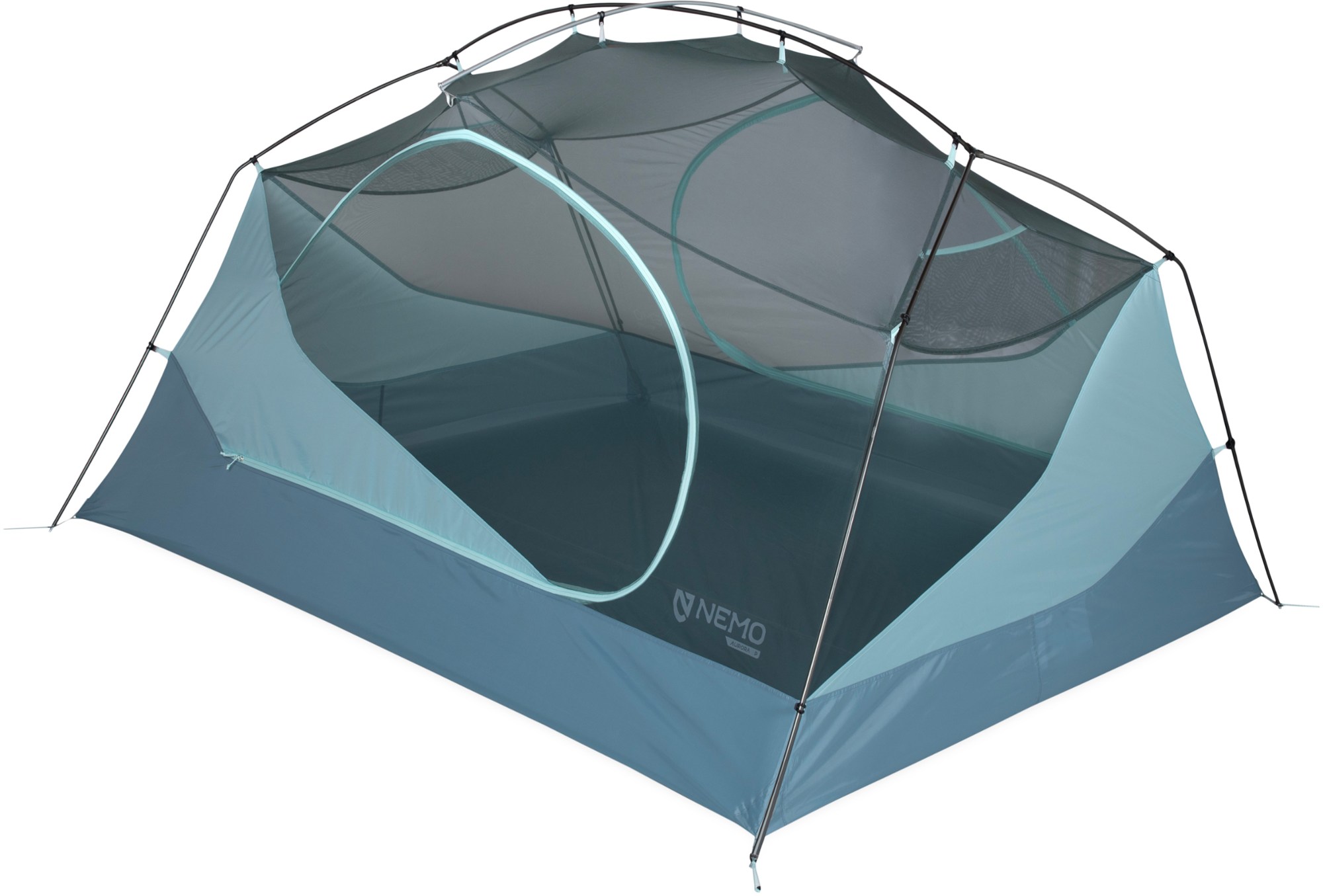 Category: Budget
Category: Budget
Packaged weight: 5 lb. 10.0 oz.
Floor dimensions: 88 x 53 in.
Capacities: 2P, 3P
What we like: Eye-catching design and steep walls at a good price; crosses over well for car camping.
What we don’t: Heavy and bulky for weight- and space-conscious backpackers.
For backpackers who care more about saving money than ounces, Nemo’s Aurora is an interesting addition to the market. And it’s not all pinching pennies here: The Aurora is impressively livable with two oversized doors, near-vertical walls, and a full-coverage fly with built-in vents. The symmetrical design and Nemo’s intuitive hardware make setup easy, and thoughtful internal storage is great for staying organized at camp. All in all, we’ve found that Nemo tents consistently are high-quality and offer a nice array of well-considered features, and the Aurora falls right in line.
The Aurora was updated fairly recently, with key changes including an added inch of width, a slightly thicker floor (from 68D to 75D), and a 3-ounce bump in weight. Nemo also upped the sustainability focus, including utilizing recycled materials and more environmentally friendly water-repellent coatings. However, we’re disappointed that the tent no longer comes with Nemo’s Pawprint for protecting the floor, which we found to be very useful when camping with our dog. Speaking of camping, the Aurora is far from a weight or bulk leader at over 5 pounds all in, making it well suited for those who want a tent for both front- and backcountry use but less so for weight- and space-conscious missions. To be fair, the package is entirely manageable, especially if you split the load with a partner, but frequent backpackers will likely want to step up to the Dagger or Hornet Elite Osmo above.
Read more: Nemo Aurora 3P review
See the Nemo Aurora 2P
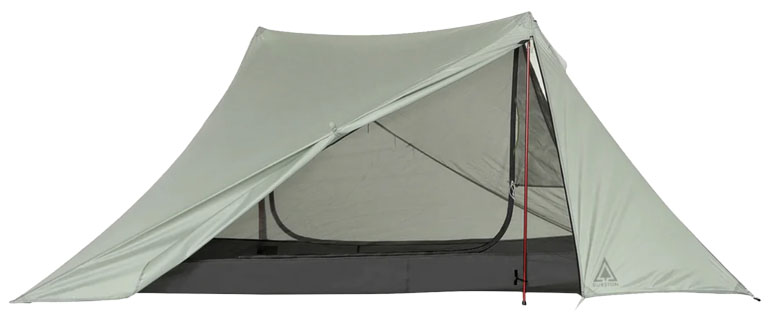 Category: Ultralight
Category: Ultralight
Packaged weight: 1 lb. 15.0 oz. (trekking pole-supported)
Floor dimensions: 92 x 52 in.
Capacities: 1P, 2P
What we like: A thoughtfully engineered, double-wall trekking-pole shelter for just $284.
What we don’t: Heavier and not as long-term waterproof as the Dyneema Zpacks above.
A lot goes into making a solid tent at a low weight, so ultralight price tags can be fairly steep compared to standard backpacking tents (as evidenced by the Nemo Hornet Elite and Zpacks Duplex Zip above). It’s for this reason that the Durston X-Mid is such a surprising entry. Like many trekking-pole shelters, the X-Mid 2 is well built, stormworthy, roomy, and checks in for less than 2 pounds. But at just $289 (without stakes), it’s less than half the price of many tents in its weight class. Importantly, there’s nothing about the X-Mid that is cheap: It features a double-wall build, which does a lot to boost ventilation (a rarity among trekking-pole shelters), along with a polyester fly that doesn’t sag when wet and an innovative parallelogram shape that ensures that the doorways aren’t blocked by poles. It also received some notable updates in 2025, including revised seams and seam taping, redesigned pockets, improved hardware, and slightly thinner (15D) fabric that shaves about 9 ounces off the weight of the previous version.
How does Durston manage to make the X-Mid at such a low price point? In short, with compromises that will be fairly minor for most but might add up for serious users. The X-Mid is about 11 ounces heavier than the Duplex Zip, which could be a dealbreaker for thru-hikers set on a low base weight. What’s more, the sil/PEU polyester fly will gradually lose its waterproofing over time, while Dyneema is naturally hydrophobic. Plus, the latest reduction from 20D to 15D fabric might affect its long term durability (we have the current version in testing and will report back with our feedback). And for just a bit more dough (and 11 oz.), the Tarptent Double Rainbow above offers a more user-friendly setup with standard tent poles, although the Durston is the better-ventilated and more spacious design (and once you get the hang of the trekking pole setup, it’s a breeze). For UL hikers looking for a very high-quality budget tent, it’s truly hard to beat. If you venture out solo, you can save even more with the X-Mid 1 ($239 without stakes).
Read more: Durston X-Mid 2 review (prior version)
See the Durston X-Mid 2
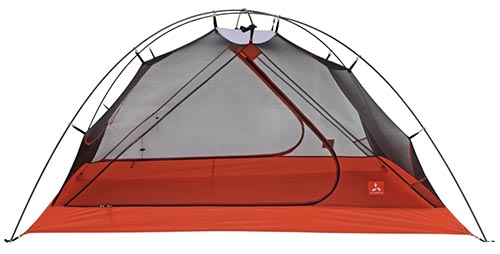 Category: All-around
Category: All-around
Packaged weight: 3 lb. 5.0 oz.
Floor dimensions: 85 x 51/42 in.
Capacities: 1P, 2P, 3P
What we like: A lightweight 3-season tent with a number of unique and noteworthy features.
What we don’t: All-mesh body is vulnerable to the elements; not as weather-worthy as we were hoping.
SlingFin might not be a household name, but don’t be fooled: This company knows how to make a serious tent. Established by the original Mountain Hardwear tent designer (also a former TNF and Sierra Designs designer), SlingFin is employee-owned and self-describes as “small, lean, and scrappy,” specializing in high-quality tents with no constraints. The Portal is their most popular and lightest freestanding design, alleged to handle rough weather with more ease than most 3-season tents. SlingFin accomplishes this feat by way of internal guylines, a plethora of exterior guy-out points, secure connections between the fly and poles, and attachments that allow you to reinforce the structure with trekking poles. And as a nice touch, the Portal also features pre-installed spare zipper sliders on both doors, which quickly extends the life of the tent (and makes in-the-field repairs easy).
We brought the Portal 2 backpacking in Patagonia, thinking the windy environment would be an excellent testing ground for a tent that claims to be between 3- and 4-season categories. Unfortunately, we faced conditions that were unfair for almost any tent, and spent a night with the Portal collapsed on top of us, bivy-sack style (we did not set it up with trekking pole reinforcements, which would certainly have helped). It is worth noting, however, that the SlingFin didn't fare as well as other tents we had with us that night, including the much heavier Sea to Summit Ikos (we suspect some of this is due to the Portal's lighter poles and predominantly mesh upper). In the end, the Portal 2 is a great 3-season tent with a premium fit and finish (it falls in the same category as models like the Copper Spur and Dagger above), but we just can’t get behind SlingFin’s strong claims regarding its weather resistance.
See the SlingFin Portal 2
 Category: All-season
Category: All-season
Packaged weight: 5 lb. 5.0 oz.
Floor dimensions: 86 x 43 in.
Capacities: 2P, 3P, 4P
What we like: An absolute tank in high winds.
What we don’t: Expensive and overkill for mild conditions.
For hitting the backcountry in winter or even treks in inhospitable places like Nepal or Peru, you’ll most likely want a step up in toughness and warmth from the 3-season tents that dominate this list. Enter Hilleberg’s fantastic Nallo (Hilleberg describes it as “all-season” and they don’t use that designation lightly). With a tunnel-like shape as opposed to a traditional dome layout, the Nallo excels in strong gusts and heavy precipitation. Just face either end of the tent in the direction of the wind, batten down the hatches with the many guylines, and sleep in relative peace. We used the Nallo in some brutal weather above the Arctic Circle and came away extremely impressed with its toughness.
The Achilles' heel of the Nallo is breathability. If you’re backpacking in warm conditions, it struggles to ventilate and can build up serious condensation on the inner walls. It’s for this reason that we’re such big fans of the Nemo Kunai, which has canopy walls that unzip to reveal breathable mesh. Other downsides of the Nallo include the steep price and hefty build, which is over a pound heavier than the MSR Access above. What's more, the Hilleberg features just one door and vestibule—if you want a step up in convenience, check out their Allak 2 instead. In the end, there’s no denying that Hilleberg tents are expensive, but their ridiculously high quality and stalwart weather protection make them top choices for guides, avid explorers, and those headed into seriously inclement conditions.
See the Hilleberg Nallo 2
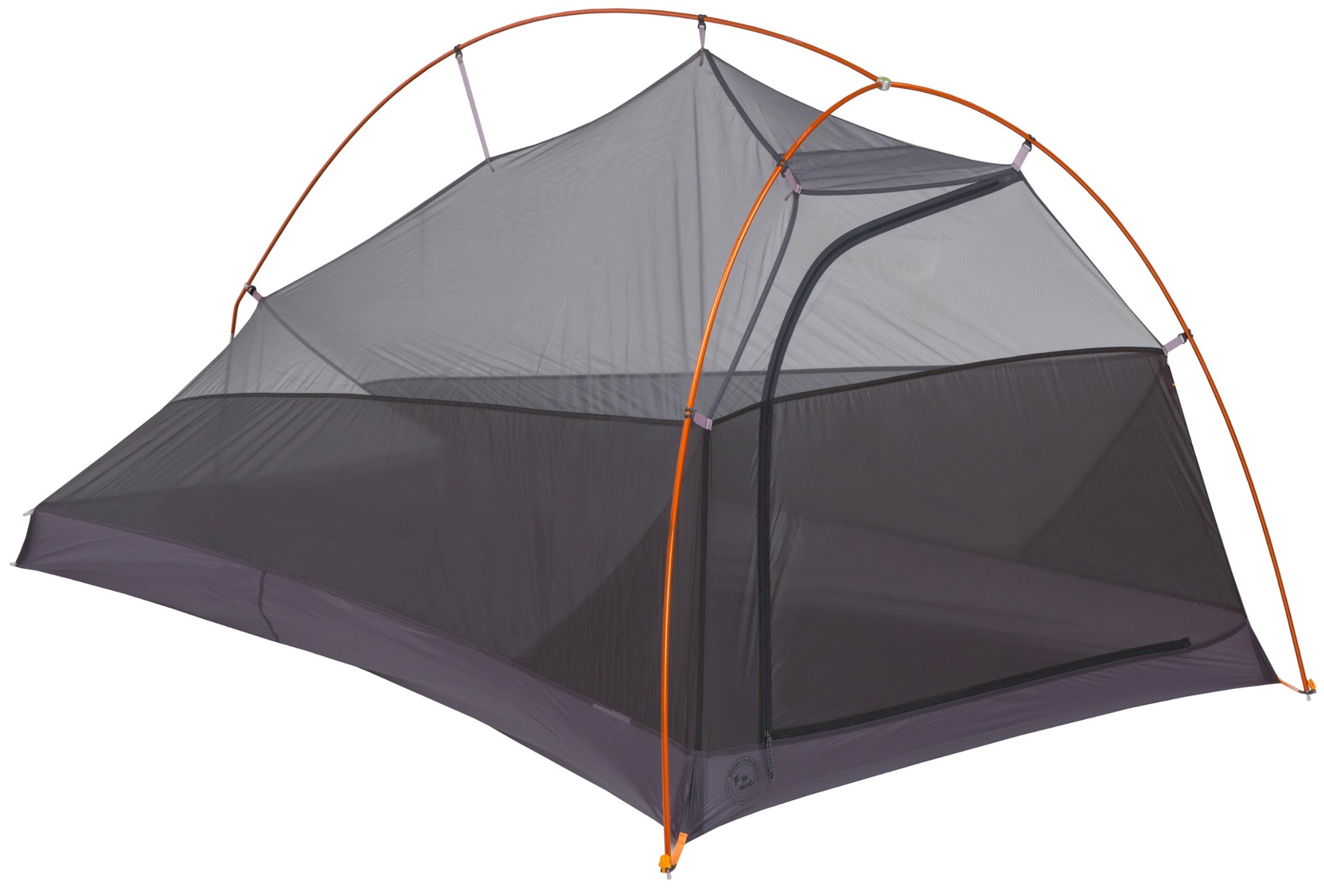 Category: Ultralight
Category: Ultralight
Packaged weight: 2 lb. 4.0 oz.
Floor dimensions: 86 x 52/42 in.
Capacities: 1P, 2P
What we like: Ridiculously lightweight for a semi-freestanding tent.
What we don’t: Just one door and vestibule; terrible in high winds.
Fast-and-light hikers love the Big Agnes Fly Creek UL—the two-person version weighs in at a scant 2 pounds 4 ounces, which is comparable to a decent bivy sack or hammock. This feathery weight is accomplished with a single door at the head end, an interior that tapers aggressively towards your feet, and a hubbed pole that runs the length of the tent in a spine-like shape. The tent and rainfly fabrics are also impressively strong despite being so thin they’re semi-see-through.
It's important to be aware that the Fly Creek won’t offer the same protection from the elements as a sturdier design like the Nemo Dagger or MSR Hubba Hubba above. The rainfly is prone to sagging onto the tent body (guying it out thoroughly will help alleviate this issue), and the fairly simple pole structure means the tent collapses inward during heavy winds. What’s more, the all-mesh body is vulnerable to drafts and does a poor job of keeping out flying dirt and sand. In the end, we think the Tiger Wall and Nemo Hornet Elite are the better all-around UL choices for parties of two, both of which utilize two-door-and-vestibule layouts for just a few ounces more.
Read more: Big Agnes Fly Creek HV UL2 review
See the Big Agnes Fly Creek UL2
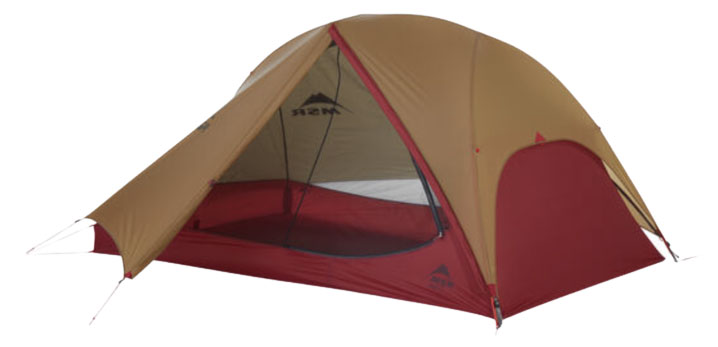 Category: Semi-freestanding tent
Category: Semi-freestanding tent
Packaged weight: 2 lb. 5.0 oz.
Floor dimensions: 84 x 50 in.
Capacities: 1P, 2P, 3P
What we like: Non-tapered footprint offers more versatility with sleeping arrangements.
What we don’t: Truncated fly; not as much headroom as the Tiger Wall.
MSR’s FreeLite 2 goes head-to-head with top ultralight models like the Nemo Hornet Elite and Big Agnes Tiger Wall, boasting a similar two-door, two-vestibule layout that’s far more convenient for two backpackers than one-door options like the Fly Creek. One standout feature is the FreeLite’s non-tapered floor, which offers more usable space for side-by-side sleeping (or head-to-toe, if that’s your thing) and helps avoid that cramped, coffin-like feel. To shave weight, MSR used a shortened rainfly at the head end but swapped out the underlying mesh for water-resistant fabric to add protection. We did find this wets out faster than a rainfly that extends all the way to the ground, though. We recently put the FreeLite 1 through the wringer on a rugged trek across the highlands of Kenya, East Africa where it held up admirably in high winds and tropical storms—and even held its ground against curious elephants in the night (who kept their distance). That said, prolonged rain did eventually make its way in through the shortened fly.
So with a lighter weight, more spacious floor, and similar price tag as the Tiger Wall UL2, why doesn’t the FreeLite 2 rank higher? It mostly comes down to interior livability: the Tiger Wall offers a few extra inches of headroom and a longer ridge pole that stretches the walls outward, creating more usable space for sitting up and changing. And while we appreciate the FreeLite’s more wind-resistant body with less mesh, the benefits are partially negated by its shortened rainfly, which left us vulnerable during prolonged storms. Both tents are top-tier in build quality, but for most backpackers, the Tiger Wall is the more comfortable and weather-ready choice.
Read more: MSR FreeLite 2 review
See the MSR FreeLite 2
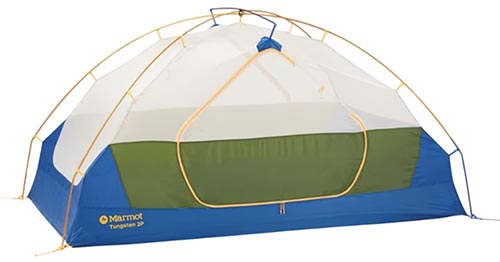 Category: Budget
Category: Budget
Packaged weight: 5 lb. 14.2 oz.
Floor dimensions: 88 x 54/46 in.
Capacities: 1P, 2P, 3P, 4P
What we like: All most weekend backpackers need in an affordable package.
What we don’t: Relatively heavy and bulky; doesn't stand out in any one area.
REI’s Trail Hut above isn't the only good value on the market. At a budget-friendly price of $249, the updated Marmot Tungsten has a similar 3-season build with durable fabrics and all the features that most weekend backpackers need. The tent has two doors and vestibules, offers a roomy 32 square feet of floor space, and comes with a footprint to maximize longevity. We also like the mix of solid nylon and mesh on the tent body, which provides good ventilation alongside privacy and weather protection. And whereas the Half Dome above has a 75-denier floor and 30-denier fly, the Tungsten ups the ante with 70- and 68-denier fabrics in the floor and fly, respectively.
All things considered, the Marmot Tungsten makes a nice hybrid backpacking and car camping option. Two obvious downsides are the tent's weight and packed size—it's on the heftier end at nearly 6 pounds and large enough to make it difficult to squeeze into a backpack (it’s much easier to divide the load between two people). Although it’s more expensive at $349, the REI Half Dome 2 checks in about 2 ounces less than the Tungsten yet offers considerably more floor area and vestibule space. But the Tungsten nevertheless is a solid option for penny pinchers, and we like that the newest version features solution-dyed fabric, which reduces energy and water consumption during manufacturing.
See the Marmot Tungsten 2P
| Tent | Price | Category | Weight* | Floor Dimensions | Floor Denier | Capacities |
|---|---|---|---|---|---|---|
| Big Agnes Copper Spur | $550 | All-around | 3 lb. | 88 x 52/42 in. | 15Dx20D | 1, 2, 2+, 3, 3+, 4, 5P |
| REI Co-op Trail Hut 2 | $229 | Budget | 5 lb. 15.0 oz. | 88 x 52 in. | 66D | 2P |
| REI Co-op Half Dome 2 | $299 | Budget | 5 lbs. 12.1 oz. | 88 x 52 in. | 75D | 2, 2+, 3P |
| Nemo Hornet Elite Osmo 2P | $660 | All-around | 2 lb. 1.0 oz. | 85 x 50/42 in. | Unavail. | 1, 2P |
| MSR Access 2 | $800 | All-season | 4 lb. 1.0 oz. | 84 x 50 in. | 30D | 1, 2, 3P |
| MSR Hubba Hubba LT 2P | $550 | All-around | 3 lb. 6.0 oz. | 88 x 52 in. | 20D | 1, 2, 3P |
| Zpacks Duplex Zip | $729 | Ultralight | 1 lb. 4.4 oz. | 90 x 45 in. | 1 oz/sqyd | 2, 2+, 3P |
| Big Agnes Tiger Wall UL3 | $530 | Ultralight | 3 lb. | 86 x 66/60 in. | 15D | 1, 2, 3P |
| Nemo Dagger Osmo 2P | $550 | All-around | 3 lb. 15 oz. | 88 x 50 in. | Unavail. | 2, 3P |
| Tarptent Double Rainbow | $349 | Ultralight | 2 lb. 10.0 oz. | 88 x 50 in. | 30D | 1, 2, 3P |
| Sea to Summit Telos TR 2 | $449 | All-around | 3 lb. 10.7 oz. | 84 x 53/43 in. | 20D | 2, 3P |
| Nemo Aurora 2P | $300 | Budget | 5 lb. 10.0 oz. | 88 x 53 in. | 75D | 2, 3P |
| Durston X-Mid 2 | $289 | UL/budget | 1 lb. 15.0 oz. | 92 x 52 in. | 15D | 1, 2P |
| SlingFin Portal 2 | $560 | All-around | 3 lb. 5.0 oz. | 85 x 51/42 in. | 20D | 1, 2, 3P |
| Hilleberg Nallo 2 | $1,015 | All-season | 5 lb. 5.0 oz. | 86 x 43 in. | 70D | 2, 3, 4P |
| Big Agnes Fly Creek UL2 | $400 | Ultralight | 2 lb. 4.0 oz. | 86 x 52/42 in. | 20D | 1, 2P |
| MSR FreeLite 2 | $465 | Ultralight | 2 lb. 5.0 oz. | 84 x 50 in. | 15D | 1, 2, 3P |
| Marmot Tungsten 2P | $249 | Budget | 5 lb. 14.2 oz. | 88 x 54/46 in. | 68D | 1, 2, 3, 4P |
*Editor's note: "Weight" refers to the packaged weight of each tent, with the exception of trekking pole-supported models.
From lofty peaks in the Cascades to the hot, dusty African savannah, the Switchback Travel team has pitched hundreds of different tents in just about every environment and climate imaginable. We know the importance of a lightweight but stalwart shelter for comfort, safety, and efficiency in the backcountry and set a high bar for tents that earn a spot in our packs—and in the rankings above. Pulling from his experience on endless treks in the Pacific Northwest and extensive international expeditions alike, former editor-in-chief John Ellings hand-picked our initial collection of eight tents back in 2015. Senior editor Chris Carter took over this guide in 2024. A lifelong backpacker and alumnus of each of the Triple Crown trails in the United States (AT, PCT, and CDT), Chris has arguably spent more time under a flimsy sheet of silnylon than a real roof.
We consider several key factors before giving tents any real estate in this guide. Livability is an obvious place to start, and we look for designs that effectively balance roominess with weight and durability (there's always a trade-off). Weather protection and ventilation are also top considerations, along with vestibule space, interior storage, and ease of setup. Each of the 18 models above had to stand out in multiple categories and prove themselves on grueling real-world tests to land a spot on our list. Rest assured, we will continue to research and test the latest and greatest options on the market and update this guide accordingly. If you want to dig into more details before making a decision, be sure to also check out our article on how to choose a backpacking tent.
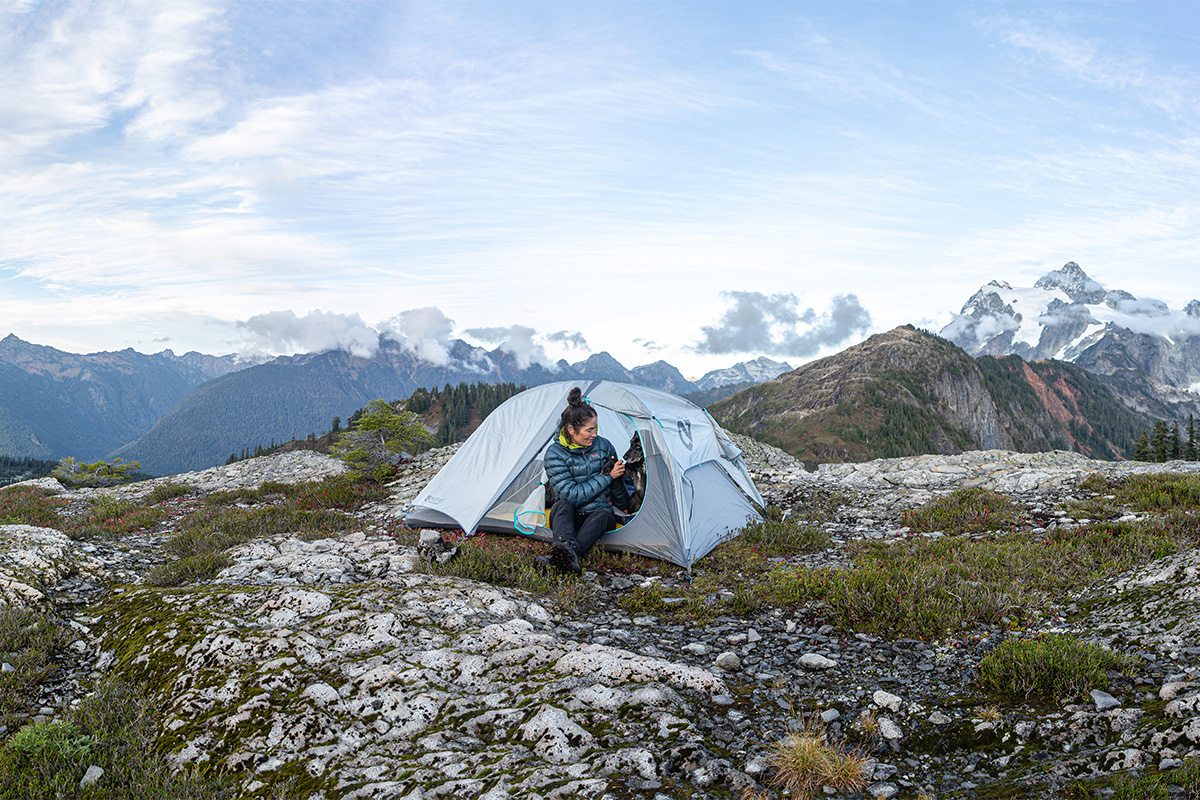
There are as many styles of backpacking tents as there are backpackers, from streamlined thru-hiking-inspired designs to durable and comfortable classics. It follows that when deciding on a tent, you’ll first want to think about what backpacking looks like for you. Are you someone who gets out every weekend of the summer, or just a few days a year? Do you like to travel fast and light or prioritize comfort and durability? How much space do you need? Below, we break the field down into four separate categories: all-around, budget, ultralight, and all-season.
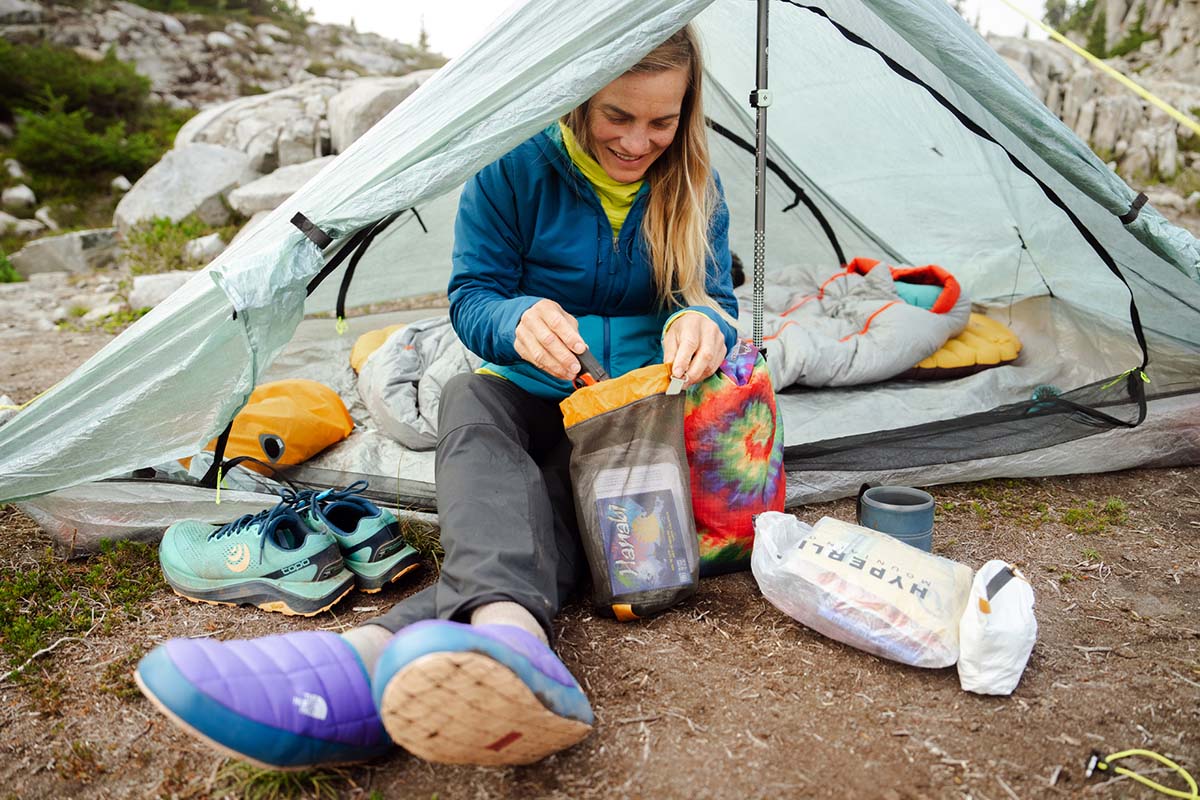
All-Around
Backpacking tents in our all-around category are the core of the market. These tents offer the best combination of livability and weight-savings, checking in around 3 to 4 pounds (for a 2P model) and featuring complex pole structures that result in steep walls and generous interior space. Their design also translates to impressive stability in high winds and great wet-weather protection. Further, most all-around tents feature two doors and two vestibules, which adds a great deal of convenience and storage. But there are a few caveats: These tents are expensive (our top-ranked Big Agnes Copper Spur UL2 is $550) and aren't particularly durable, with relatively thin fabrics and zippers. Finally, although all-around tents are very doable for two sleepers, you’ll often find larger floor plans in our budget category. But for class-leading performance, tents in our all-around category are our top choice for most.

Budget
If you’re new to backpacking or only get out a few times a year, it’s worth taking a look at a budget tent. Most of these designs have an MSRP of less than $350 and are defined by their thicker fabrics, simple pole structures, and heavier builds. Comfort is high, with spacious floor plans that don't compromise for weight-savings, two doors and two vestibules, and lots of storage. And with considerably more durable fabrics, they can withstand much more use and abuse, which is good news for those who don’t want to spend too much time taking care of their gear. It's true that budget tents lack the fancy architecture and low weights of more expensive tents here, but in our opinion, they're all beginners need and nothing they don’t. From our list above, the REI Co-op Trail Hut 2 is our favorite budget tent, and you can bump up to the Half Dome 2 for an impressive mix of price and performance.
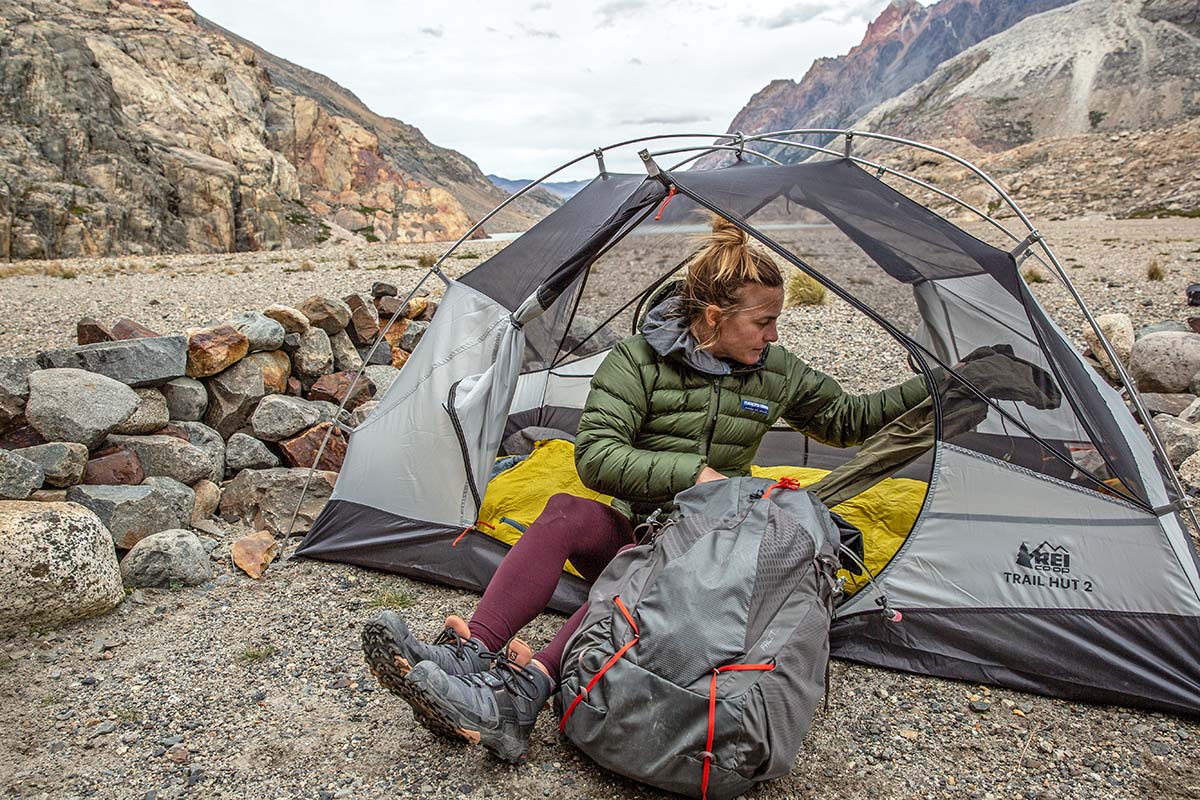
Ultralight
Weight-conscious thru-hikers have relied on bare-bones shelters for a long time but only recently has the ultralight craze hit mainstream backpacking. The number one consideration here is keeping weight to a minimum (3 pounds or less), which ultralight tents do by way of thin fabrics and zippers, tapered floor areas, heavily sloped ceilings, fewer doors, smaller vestibules, and simplified pole structures. Further, the majority are non-freestanding and semi-freestanding, meaning they must be staked out in order to hold their shape, often using trekking poles as the tent poles. Unsurprisingly, there are a fair share of potential trade-offs with tents in this category: They suffer in terms of weather protection (we’ve had particularly bad luck with the Big Agnes Fly Creek UL2 in high winds), require a lot of extra care, and can be fairly cramped quarters for two. Further, you'll spend up to drop weight: Most ultralight tents are $400 or more, and Dyneema tents like the 1-pound 4.4-ounce Zpacks Duplex Zip will run you $729.
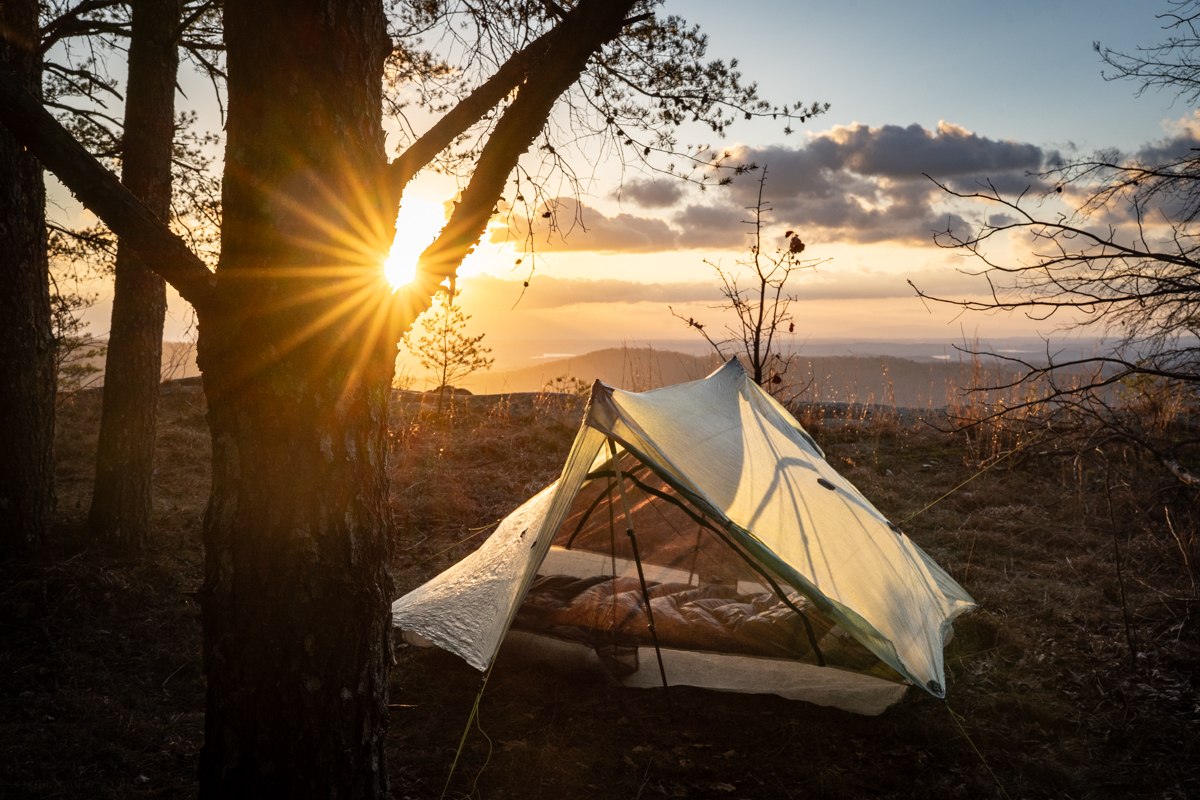
But we’re big believers that ultralight gear can be taken too far, which is what happens (in our opinion) when tent floor fabrics drop below 15 denier (as is the case with the Big Agnes Tiger Wall Platinum’s 7D floor) or when you wake up with a tent wall stuck to your face (a real life experience we had with the Six Moon Designs’ Lunar Solo). We certainly understand the appeal for thru-hikers and serious backpackers, and in the right environments, the compromises can be minimal. But for most recreational backpackers, the weight savings probably aren’t worth it. Most of the time, you can get a whole lot of comfort and convenience (not to mention a longer lifespan) by bumping up to a tent that’s just one pound heavier (at just over 3 lb., the Big Agnes Copper Spur is fairly uncompromised). For this reason, we feature a few ultralight tents here and are sure to call out their weaknesses in the write-ups above. For a deeper dive on this topic, see our article: Backpacking Tents: How Light is Too Light?
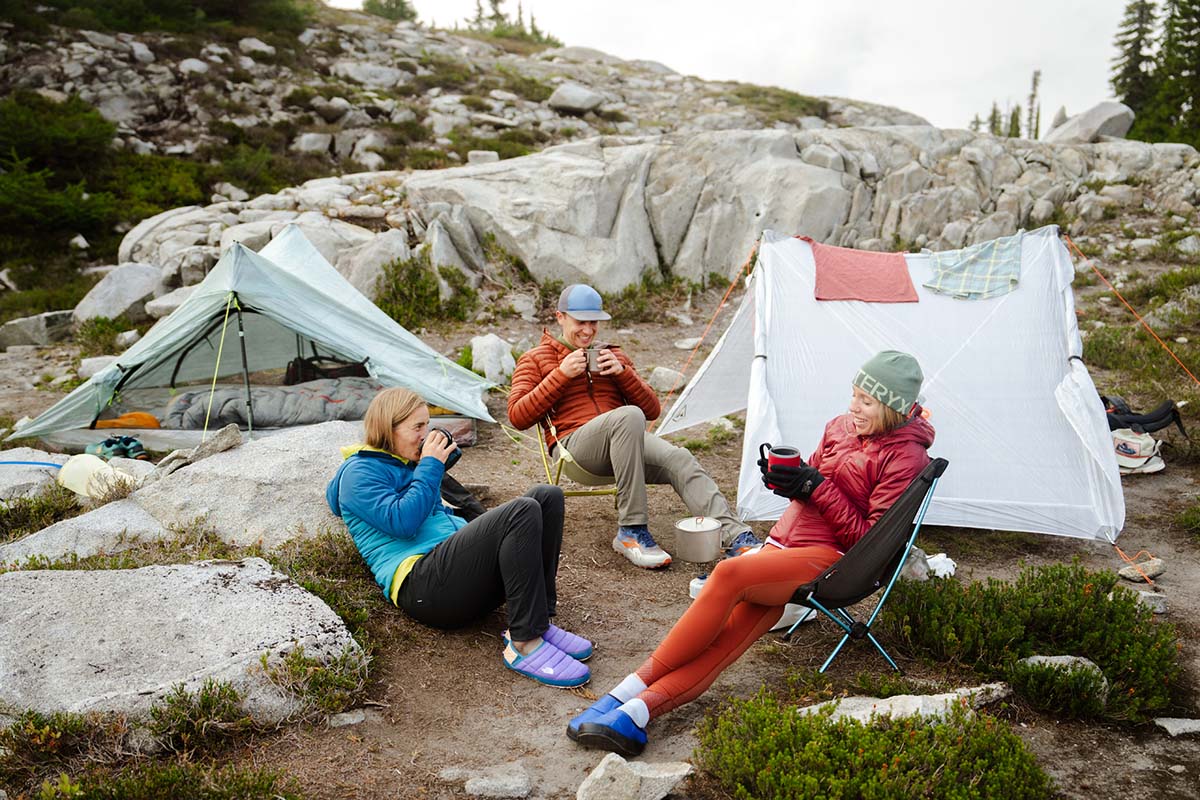
All-Season
We’ve included a few all-season tents on this list to provide a complete view of the backpacking market, including the MSR Access and Hilleberg Nallo. These tents offer more protection than your standard 3-season tent without being quite as bulky or expensive as a 4-season tent. Whereas most 3-season designs are fairly mesh-heavy, all-season tents use mostly nylon walls for better warmth and wind protection. You also get sturdier pole structures, which adds a bit of weight but is worth it when the weather turns. You can expect higher price tags and increased weights in this category, but all-season tents are nevertheless our top pick for backpacking in areas like Peru, Nepal, or Alaska. And if weight isn't your top priority, you can always bump up to a three-person version for more space.

A backpacking tent is one of the heaviest and bulkiest items you’ll pack for an overnight trip, but the good news is that modern designs are lighter than ever. The two-person tents on our list range from 1 pound 4.4 ounces for the non-freestanding Zpacks Duplex Zip to 5 pounds 15 ounces for the budget REI Co-op Trail Hut 2, with popular models like the MSR Hubba Hubba LT and Big Agnes Copper Spur UL2 settling somewhere in the 3-pound range. In general, you can expect budget tents to be the heaviest, followed by all-season, all-around, and ultralight. As is the case with most outdoor gear, shaving weight from a tent design will result in some trade-offs, often in the form of compromised durability, interior space, weather protection, or ventilation (not to mention a higher price tag). In the end, it helps to be mindful of your priorities when making your tent purchase.
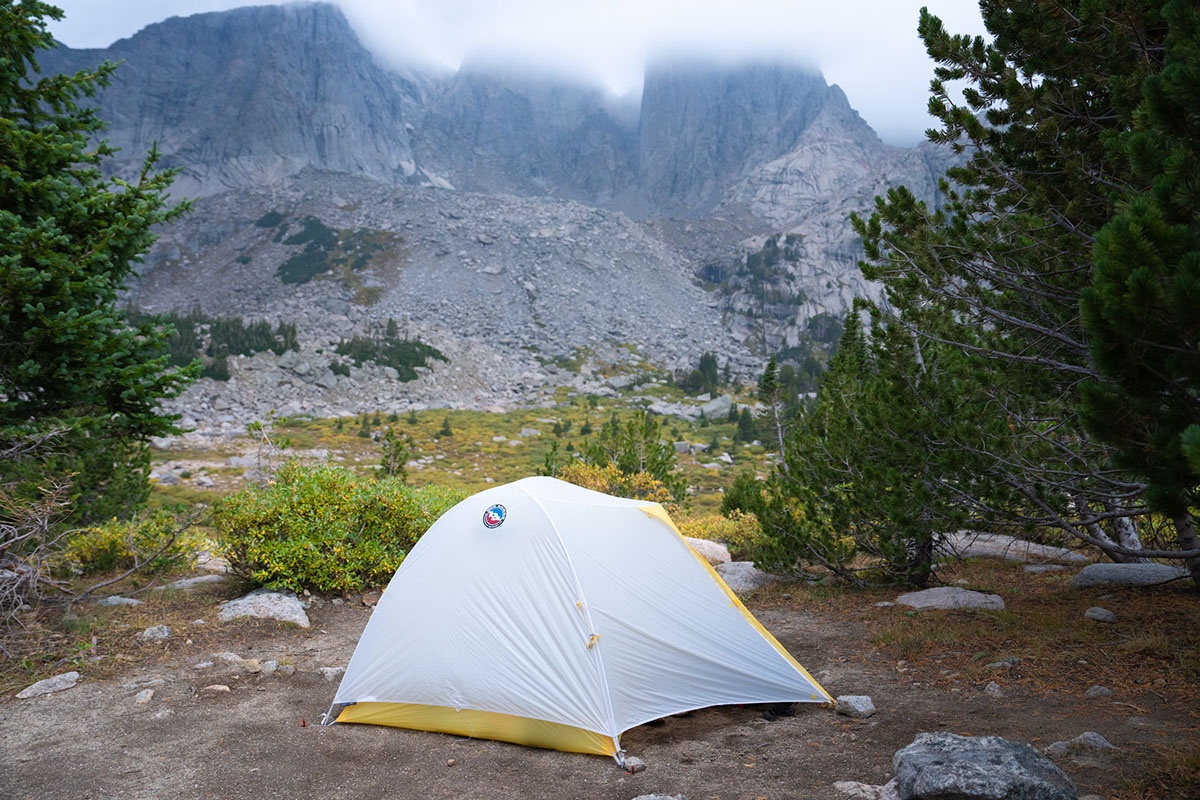
Packaged Weight vs. Trail Weight
When researching tent weight, you’ll commonly see manufacturers and retailers list two specs: packaged weight and trail weight (also referred to as "minimum weight"). The former includes everything that comes with the purchase of the tent, including the tent body, rainfly, poles, stakes, guylines, stuff sacks, and footprint (when it’s included with the tent—as is the case with REI Co-op's Trail Hut 2 and Half Dome 2). This is an important factor to consider when comparing models, as a footprint can tack on 7 ounces or more to the total tent weight, not to mention a stuff sack that may be unnecessary while backpacking.
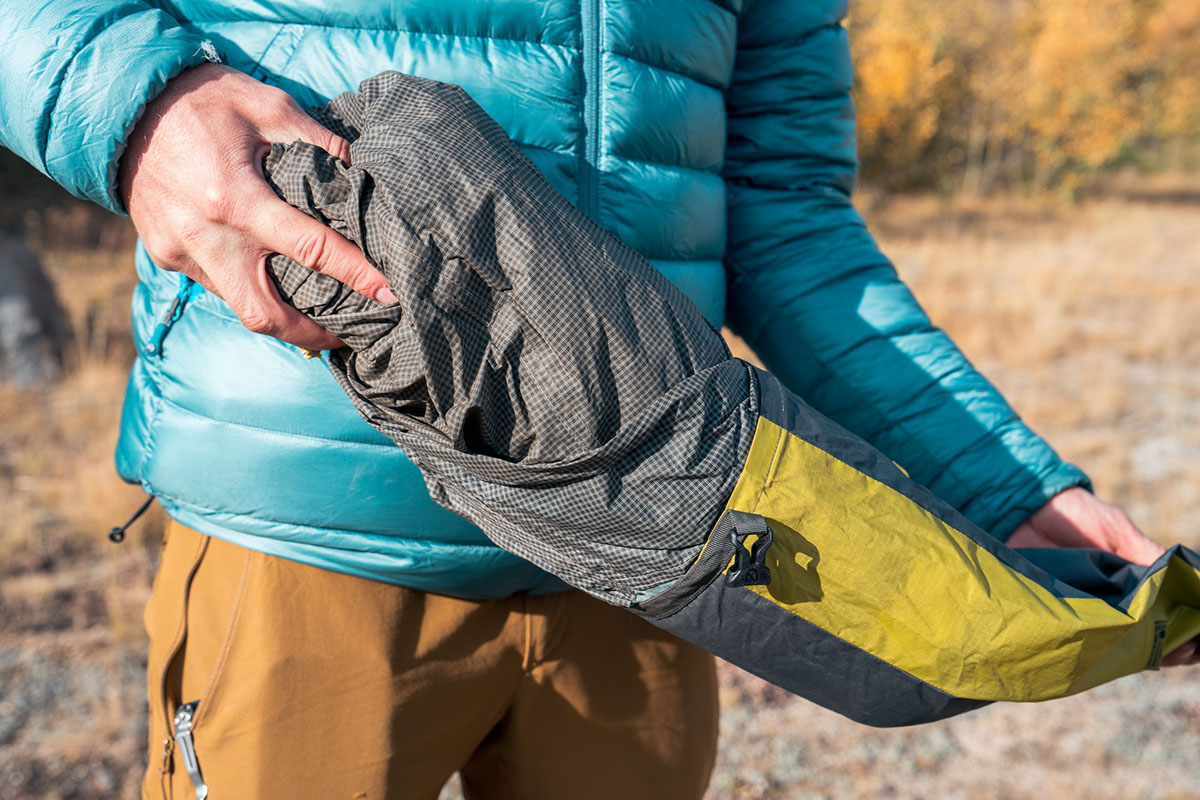
The trail weight, on the other hand, only includes the tent body, rainfly, and poles. We’ve chosen to list packaged weight in the specs above—it’s closer to what most folks realistically bring—but keep in mind that you can trim ounces from there. Depending on the build of the tent components, the difference between packaged weight and minimum weight can be substantial: anywhere from over a pound for the entry-level REI Trail Hut 2 with its heavy aluminum stakes and included footprint to a 6-ounce difference for the Big Agnes Copper Spur.
Floor Dimensions
In parsing out how roomy a backpacking tent is, the first thing you’ll want to evaluate is the floor dimensions (L x W), which matter quite a bit when you’re trying to fit two backpackers with their sleeping pads side-by-side. In general, the floor area of a tent tends to go down as weight goes down, and some two-person tents can get pretty cozy with two adults and gear inside (you always can size up to a “plus” or three-person version for more space). It’s also worth mentioning that some tents taper at the foot end, which helps shave weight but also has a negative impact on livability (making it hard to sleep head-to-toe). In these cases, we’ve provided two measurements for the floor width (86 x 52/42, for example). And a final note on floor dimensions: While they’re a good place to start, they certainly don’t tell the whole story about a tent’s interior space. It’s a good rule of thumb to take the tent’s peak height and shape into consideration as well, and in particular the slope of the walls (more on this below).
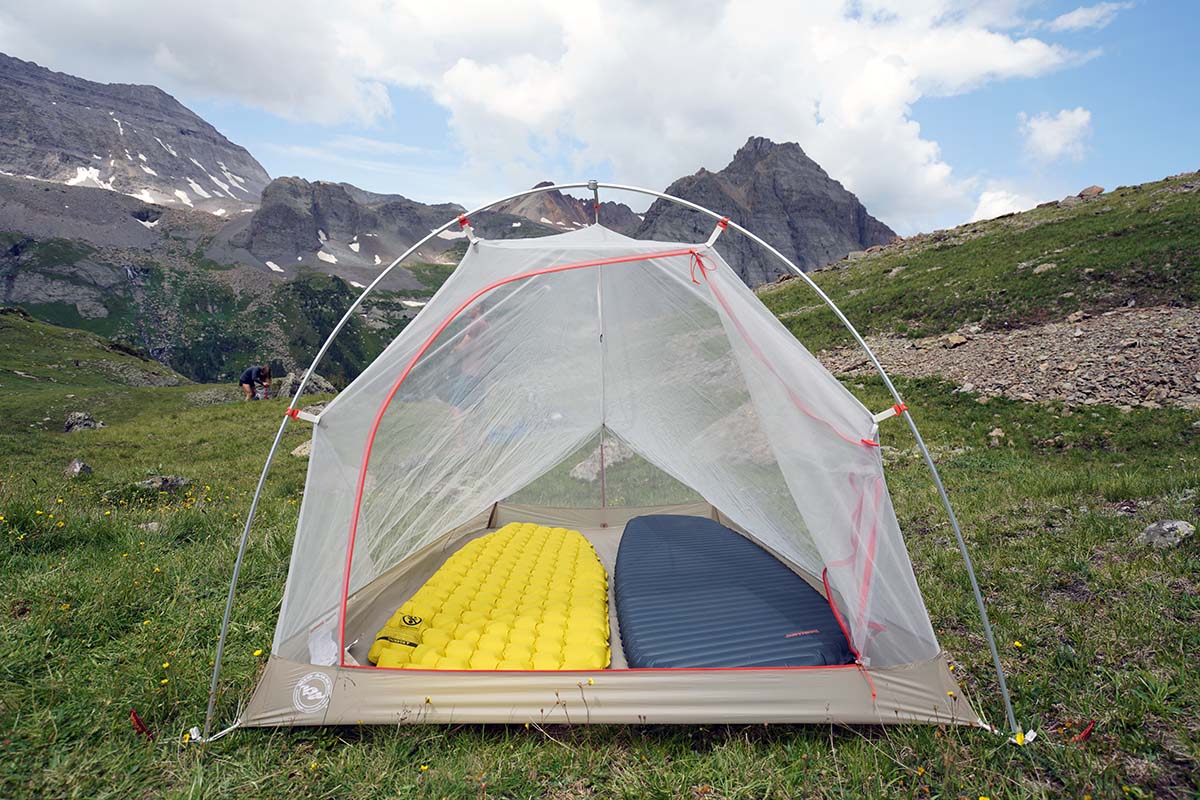
Peak Height and Slope
A tent’s “peak height” refers to its tallest point, and among two-person models varies from 39 inches for a design like the Big Agnes Tiger Wall UL2 up to 48 inches for the Zpacks Duplex Zip and Durston X-Mid 2. But while peak height does make a difference in terms of sitting up and moving around inside your tent, it’s important to also consider the slope of the walls in order to get a true picture of a tent’s livability. To understand this, just picture the difference between a pyramid-shaped tent (a tall peak height at the apex with sharply sloped walls) and a box-shaped tent, which features the same peak height throughout (headroom is the same at the sides as in the middle). Slope is a trickier subject than peak height and cannot be communicated via a simple measurement, but there are a few telltale signs to look for.
Most of today’s premium designs feature pre-bent poles and a ridge pole, both of which help to stretch the walls outward and make them near-vertical. This can go a long way in extending the peak height both length and widthwise, and is seen in popular tents like the Nemo Dagger. On the other hand, some budget and ultralight tents use simplified pole structures (or even trekking pole setups), resulting in a sharper slope and less interior space (the Nemo Hornet Elite, for example). While a tent like the Nemo Dagger is actually fun to hang out in (two people can sit face-to-face), the Hornet Elite can feel a bit like a coffin. Not everyone will need to prioritize a tent with a generous peak height throughout, but it’s especially worth it for those who anticipate bad weather or spending a lot of time inside.
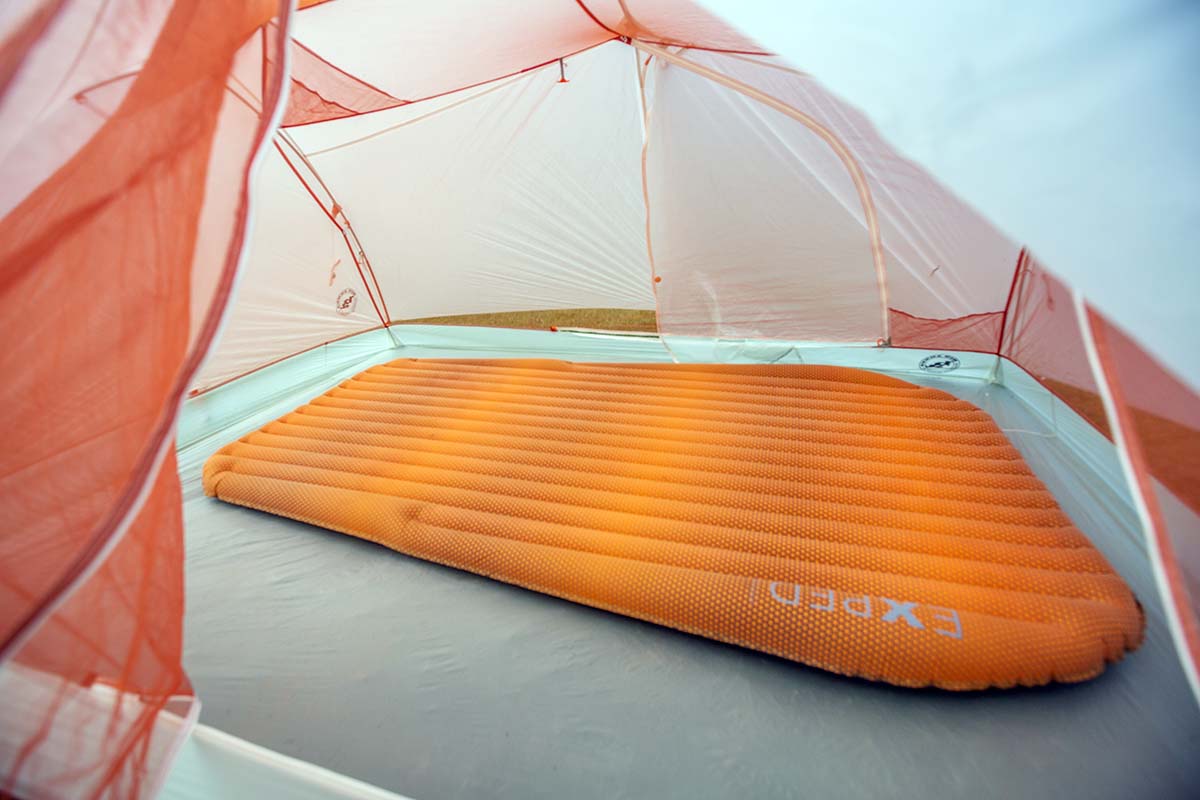
One of the easiest ways to think about tent durability is to consider the thickness of the fabric, which is measured in terms of denier (technically speaking, the weight of the yarn). The higher the denier—of the floor, canopy, and rainfly—the more durable the tent. Logically, denier lines up with weight. Ultralight gear certainly requires an extra level of care—we typically recommend using a footprint with lightweight tents and checking your campsite for sharp sticks or rocks—but it’s a sacrifice many are willing to accept to reduce their packed weight. Because the area most vulnerable to punctures or tears is the floor, this is the number we list in the specs and comparison table above.
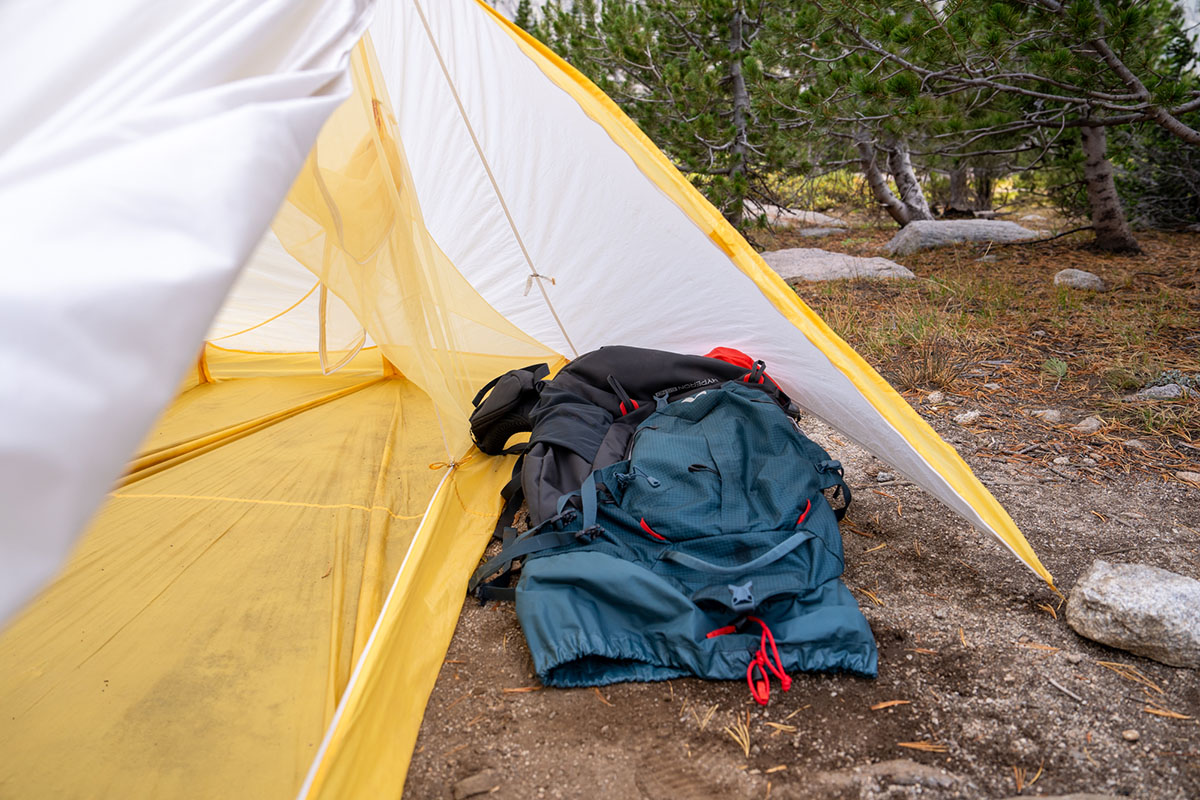
While fabric thickness is a large factor in determining a tent’s durability, it’s not the only one. The quality of the rest of the materials (poles, zippers, etc.) also plays a part, as does the attention to detail. Additionally, premium tents will often add a silicone coating (also referred to as “silnylon”) to their thin fabrics for additional tear strength and longevity, while most budget designs do not. This is an expensive process—there’s a reason Hilleberg tents are $850 or more—but the payoff is incredible toughness even on a tent like the Nallo that uses otherwise thin 30-denier fabric. We’ve learned to trust the build quality of tents from leading manufacturers like REI, Nemo, and MSR, but you’ll want to be a bit more careful with dedicated budget brands, such as Alps Mountaineering, which specialize in the entry-level market.
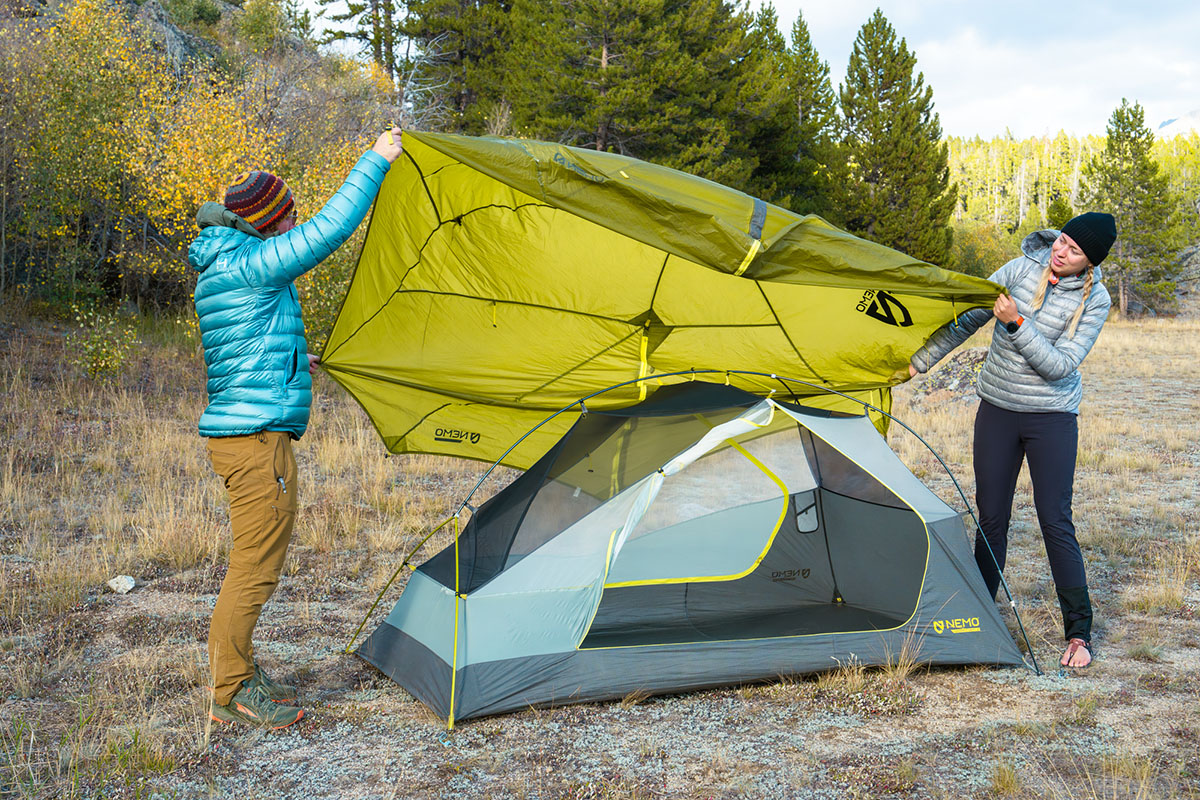
Your first line of defense in bad weather is the rainfly. As the name indicates, the rainfly covers the exposed tent body for increased resistance from precipitation, wind, and cold. Even ultralight designs have a waterproof coating, are seam-taped (or can be, inexpensively), and can withstand hours of downpour without leaking, provided they cover the entire tent body (we’ve found that most leakage actually comes from the ground around the bottom of the tent). We almost always recommend a full-coverage rainfly, although some tents like the Nemo Hornet Elite have impressive weather resistance even with some sections only protected by the tent body.
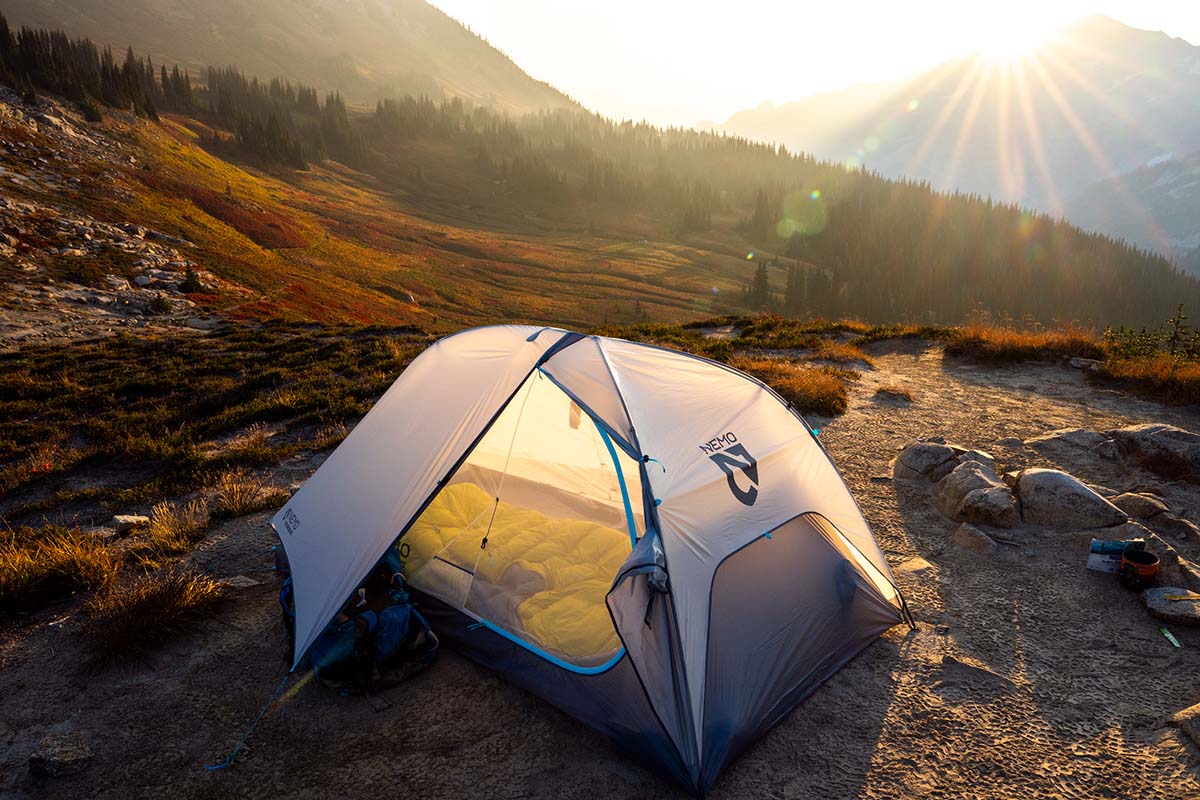
The next factor in weather resistance is the tent structure. In general, more expensive tents offer increased weather resistance (some ultralight models are exceptions). The poles and pole systems on budget tents are likely to bow during strong winds, while high-end tents like those from MSR and Big Agnes have stronger poles and tons of exterior ties to anchor yourself down during a storm.
A healthy percentage of people get up to the mountains a few weekends a year during the summer months and encounter moderate conditions in terms of temperature, wind, and precipitation. If you fall into this category, all on our list should perform admirably. We once slept in an older version of the REI Half Dome for six consecutive weeks in Patagonia with only a couple of uncomfortable nights during big storms. That being said, subsequent trips in a Hilleberg did make us appreciate the quality and bombproof feeling you get in a high-end tent.
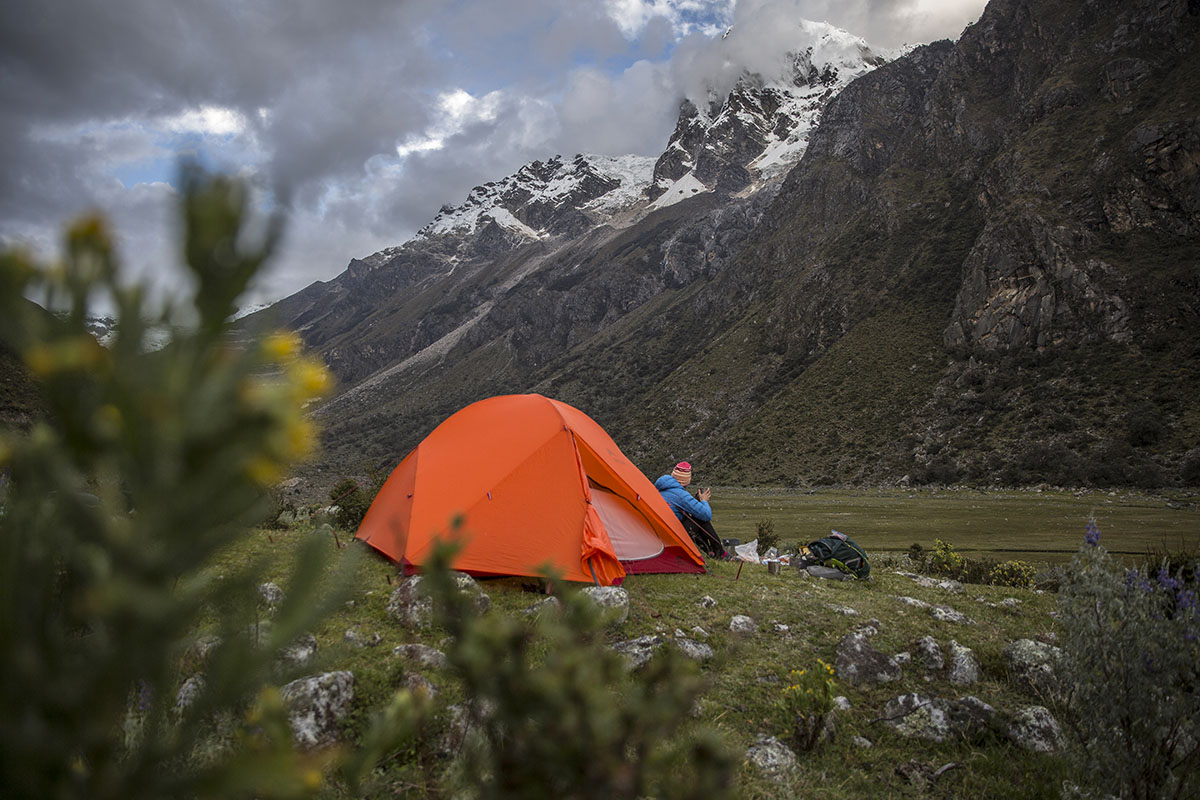
How well a tent ventilates depends on a couple of factors. First, look at the amount of mesh on the tent itself. A double-wall tent (the tent body and rainfly being two independent pieces) with liberal amounts of mesh should breathe well in mild weather. Leave the rainfly off and the tent will be even more comfortable in hot temperatures so long as the sun isn't hitting you directly. With the rainfly on, things get a little trickier. A standard rainfly has a waterproof coating to help protect the interior from getting wet, which also means the rainfly doesn’t ventilate very well, and moisture from your breath is trapped inside, creating a dewy interior.
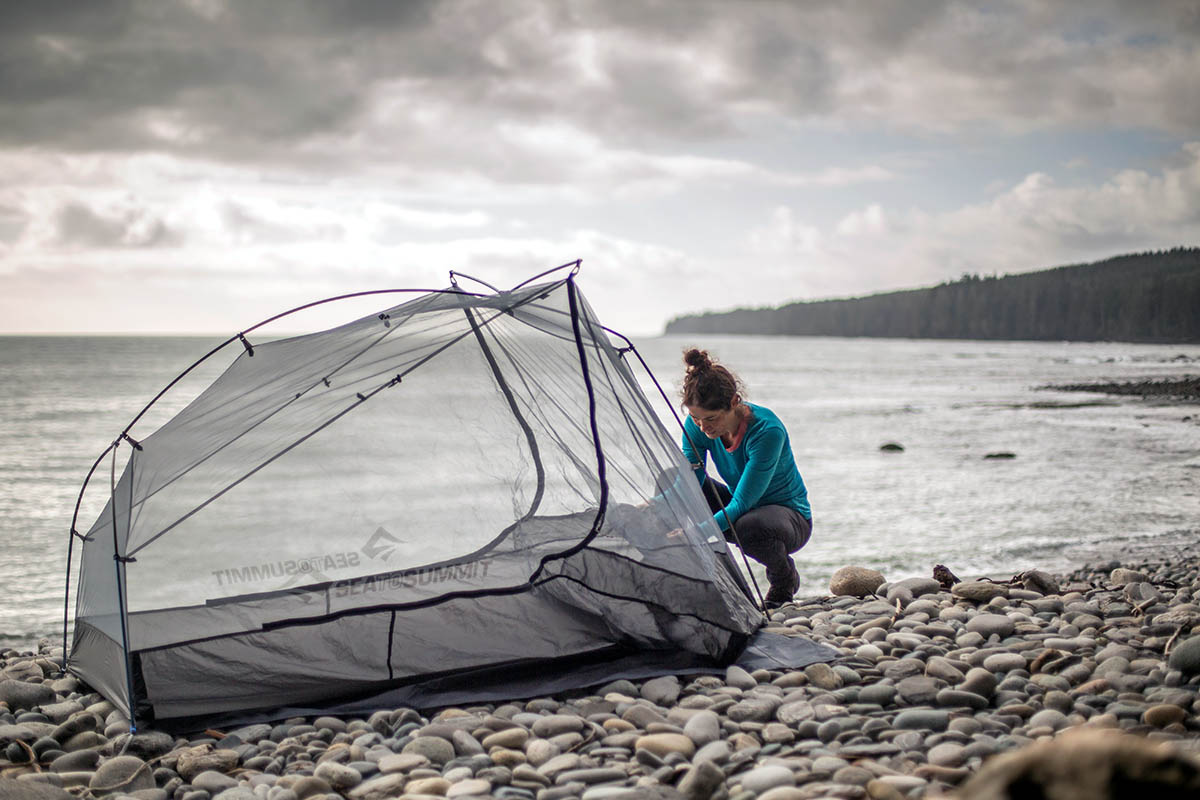
So what can you do? Tent manufacturers combat these problems by installing roof vents towards the top of the rainfly that can be deployed even in the rain. The vents are covered from the top by the rainfly fabric, so only in a strong storm with rain coming sideways will there be an issue with raindrops reaching the interior. By creating good airflow out the top of the tent, along with good spacing between the rainfly and tent body at the bottom, problems with moisture collecting on the interior of the tent can be greatly reduced. And some tents like the Sea to Summit Telos TR 2 have convertible-like rainfly designs that roll back fairly easily. You can leave half of the rainfly open for ventilation and stargazing, but if you feel a couple of raindrops during the night, it only takes a few seconds to roll the rainfly back down.
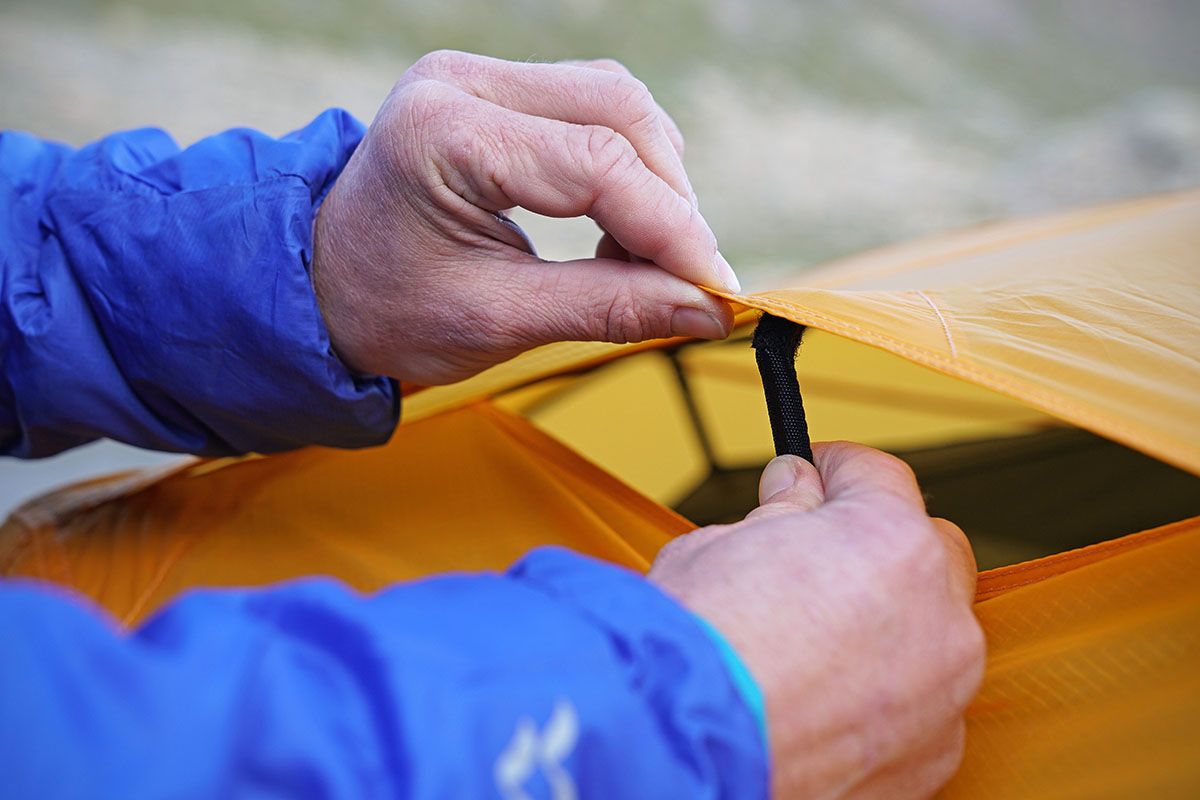
Tent storage can be broken into two categories: vestibules and gear closets outside the tent, and pockets inside the tent body for small items you need close at hand. A traditional vestibule covers the entry door to the tent with enough space for a couple backpacking packs and footwear. Without it, your options are bringing the wet and grimy gear inside the tent or letting it soak outside. Needless to say, we put a priority on some sort of outside gear storage. The amount of vestibule space is measured in square feet and can vary a fair amount. From our top picks above, the smallest vestibules are designs with just one door, like Big Agnes’ Fly Creek (8 sq. ft.). On the other end of the spectrum is the REI Half Dome’s roomy 22.5 square feet divided between two vestibules. For those camping with a partner, the REI’s added space makes staying organized (and sane) much easier.
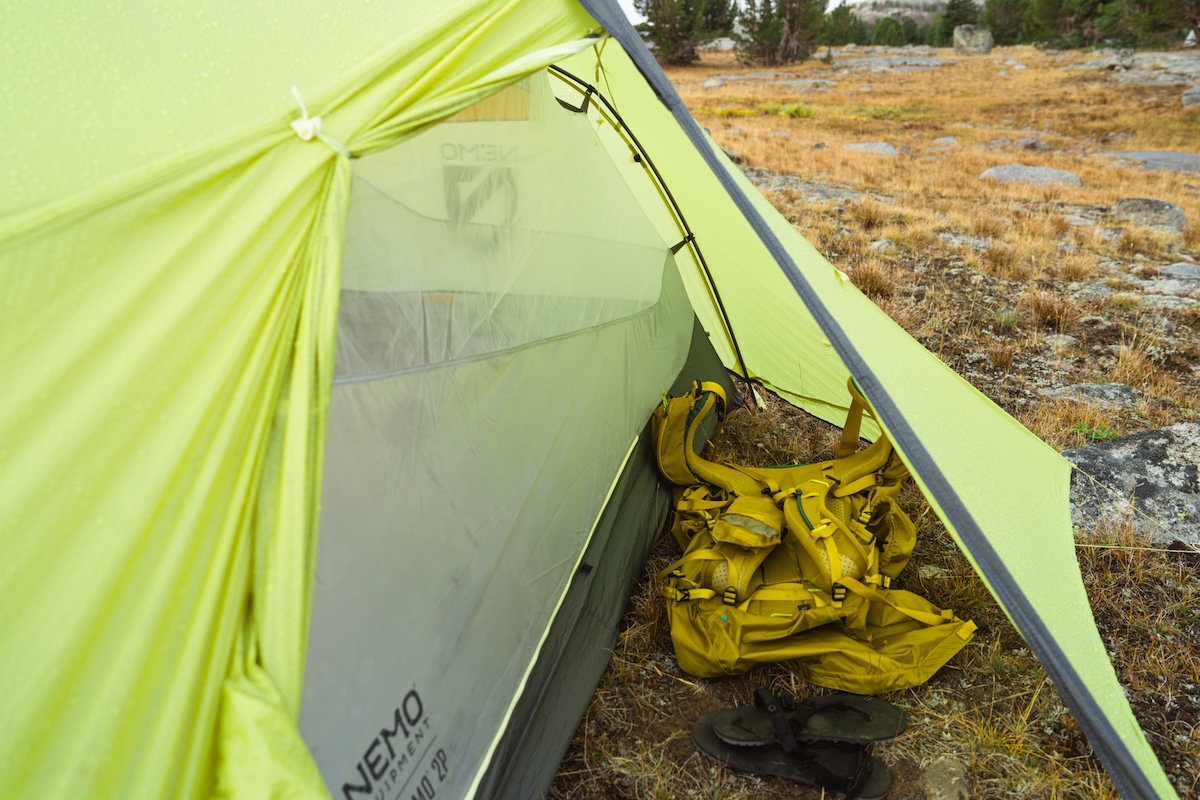
A tent with excellent interior organization isn’t a top priority; that is, until you get into the tent for the first time and look for a spot to store your headlamp, handheld GPS, or other small items. We’ve found the most helpful area for a pocket is near your head, and a simple mesh drop-in pocket or two is sufficient. Some tents have pockets along the interior of the roof, which make for an easy place to squeeze in a headlamp to light up a game of cards. Should the tent not include pockets along the roof, look to see if it has hang loops instead for securing a light. These extra little details can make your backcountry camping experience all the more enjoyable.
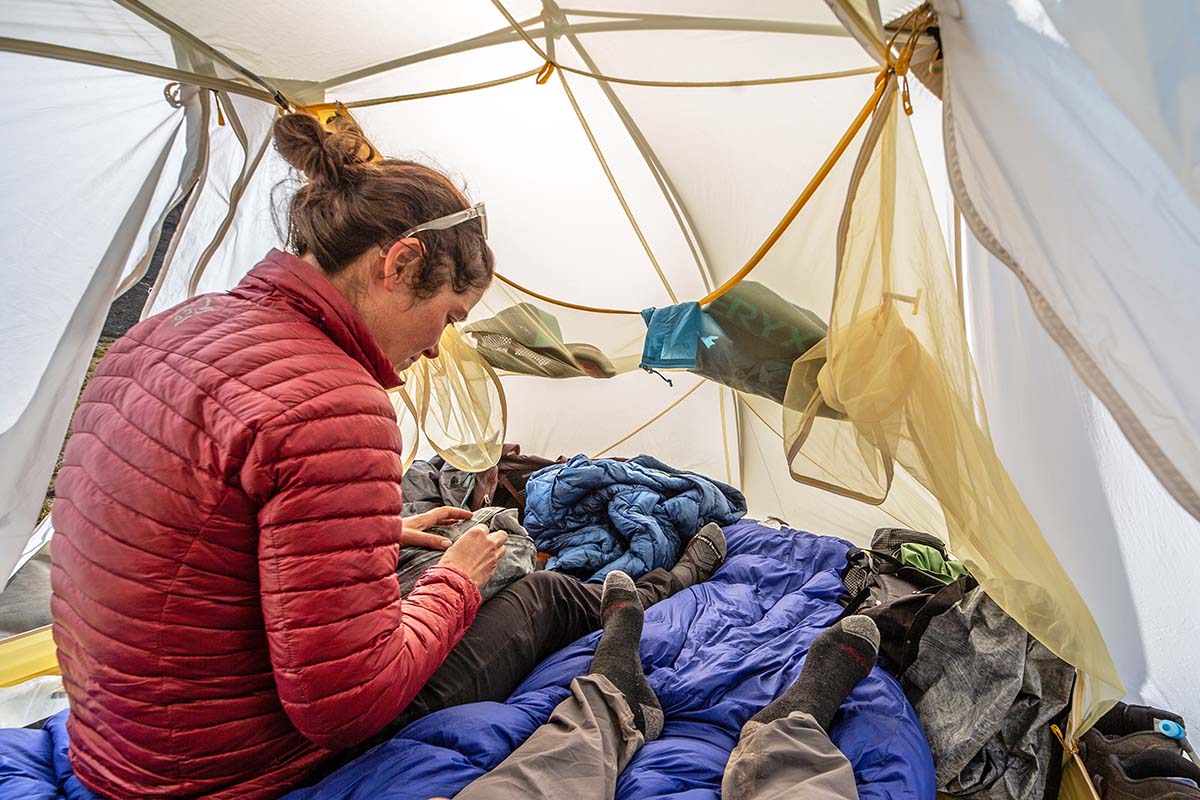
This article covers primarily two-person backpacking tents (the most common capacity), and a quick look at our picks above shows our clear preference for models with two doors. These designs are by far the most convenient if you consistently camp with a partner: Each person has their own door for getting in and out, including vestibule storage space. A few models above use just one door to save weight—the Big Agnes Fly Creek, for example, puts its door on one end. If you’re sharing the tent with a partner, this can be a major downside—you’ll be crawling over your tent mate to get in and out and will be limited to one vestibule for exterior storage. In the end, unless you’re traveling alone or pulling out all the stops to save weight, we recommend a tent with two doors.
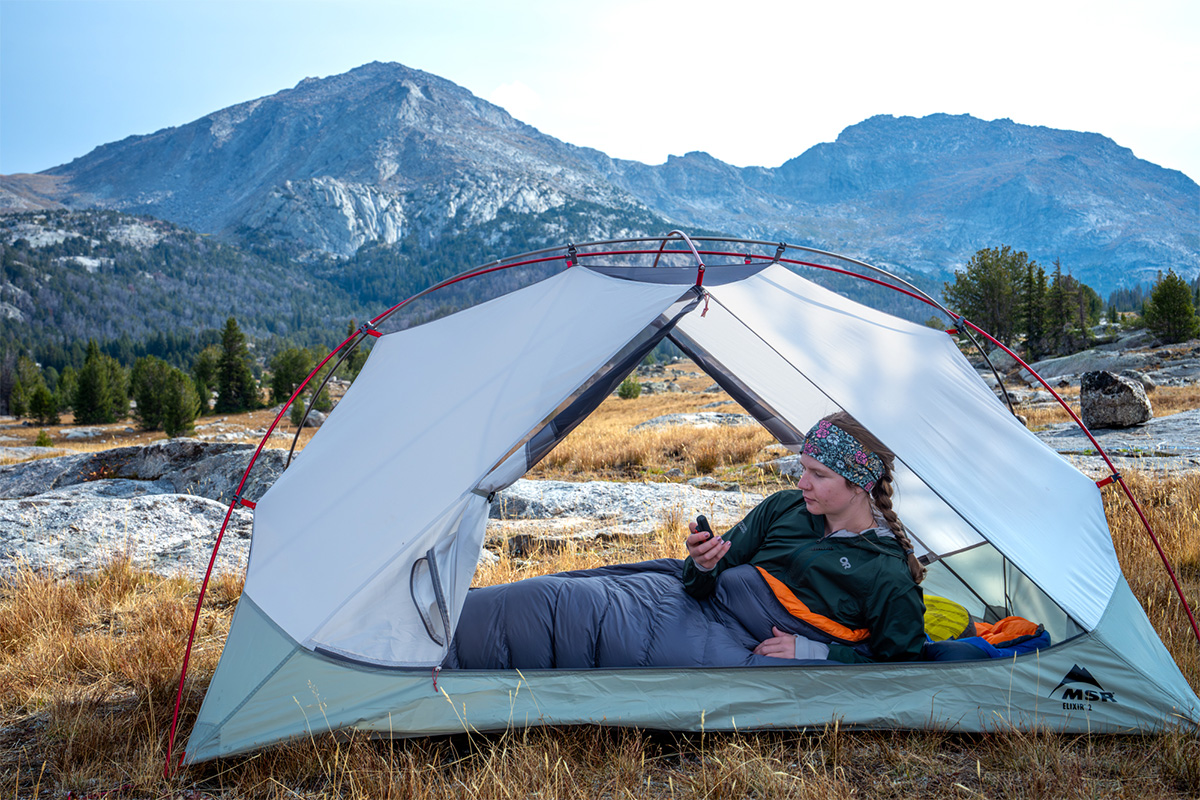
The good news for backpackers is that setting up a modern tent has become surprisingly easy. Many of us remember the fabric sleeves of old that were both time-consuming and extremely frustrating, but the majority of tents now use simple clips that take a matter of seconds to attach. In addition, tent poles have become streamlined and come together with ease. To set up most tents, you simply lay out your footprint if you have one, stake out the corners, attach the poles, and clip everything together. From there, the rainfly often can be the trickiest part (we’ve put ours on inside or backwards more times than we can count), plus you have those small Velcro attachments on the inside. But the whole process usually takes just a few minutes from start to finish, which is fantastic.
It’s worth noting that some ultralight tent systems can be more finicky to set up and definitely require some practice. When getting acquainted with shelters like the Zpacks Duplex Zip, we've found ourselves initially fumbling a bit to get everything taut and in place. And because Hilleberg tents are designed so uniquely, it can take a few tries to get setup speed where you want it to be. Regardless of your tent choice, it’s always a good idea to set it up at home first. Not only will this help guarantee that you know what you’re doing in the backcountry when the conditions may be more challenging, but it also ensures that you have all of the necessary components.
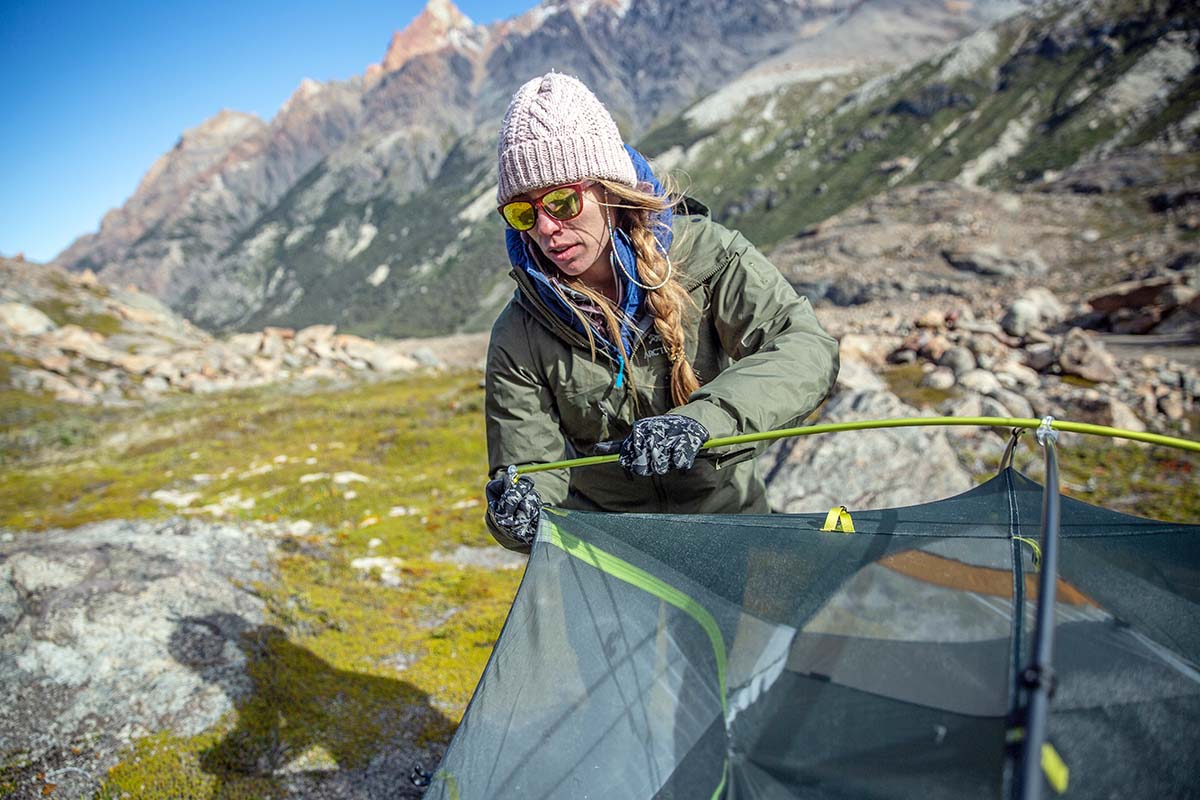
The term freestanding means that by attaching poles to the tent body, it has a solid structure and can stand completely on its own. Non-freestanding or semi-freestanding tents need to be staked out in some (or all) of the corners to create a rigid frame. The benefit of a freestanding tent is a simple setup that is far easier to move from one area of your campsite to another (or to use on a rocky surface). As a result, most mainstream tents on the market are freestanding. Non-freestanding tents require fewer pole sections, which reduces weight, and are a popular choice for backcountry enthusiasts who are well versed in choosing a good campsite and erecting a tent. Owing to their design, semi- and non-freestanding tents also tend to have more sloped walls (read: less headroom) and less interior space overall. For a deeper dive into the topic, see our article on freestanding vs. non-freestanding tents.
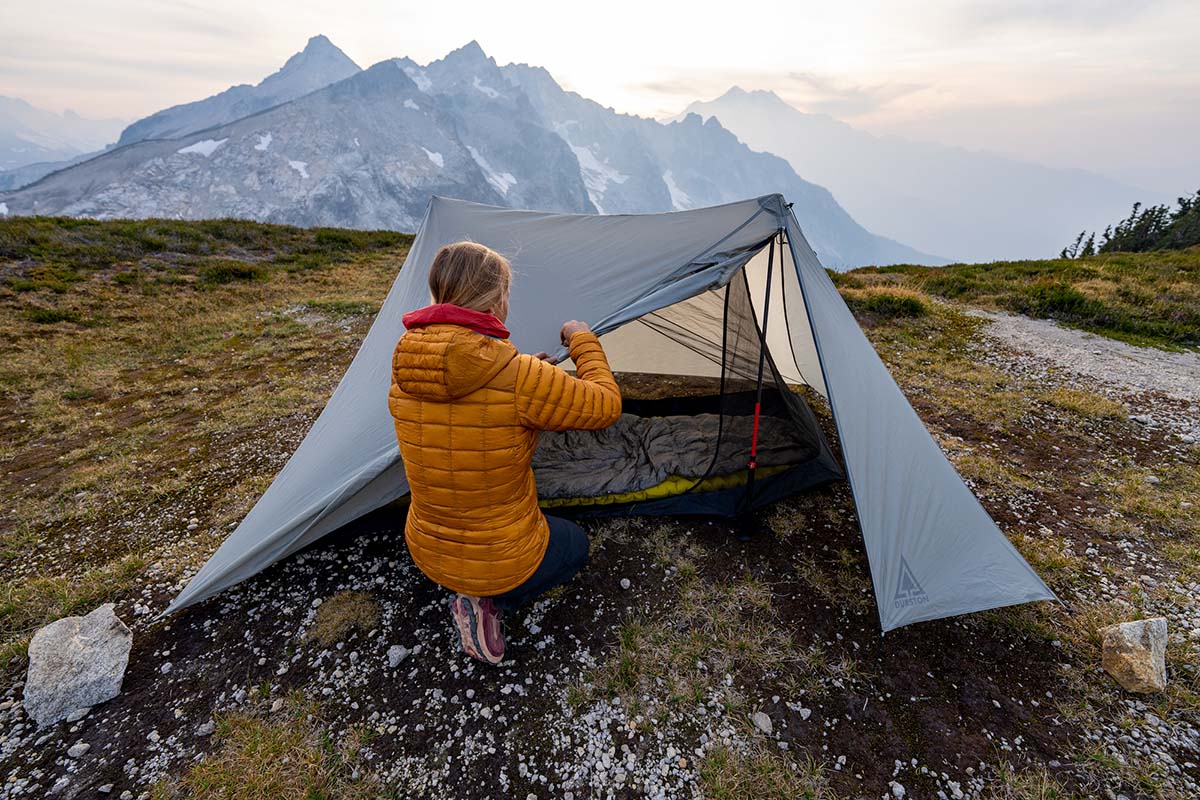
Without getting too into the nitty gritty on tent poles and stakes, there are a few important details to cover. In terms of poles, nearly every quality backpacking tent uses aluminum poles (exceptions to the rule are the Zpacks Duplex Flex and Big Agnes Fly Creek Carbon, which use carbon fiber poles). Aluminum is relatively affordable, lightweight, and will flex quite a bit prior to failing. Name-brand poles like Easton or DAC are easy to trust, although we always recommend bringing along a lightweight pole splint (like this one from Gear Aid) in case of failure mid-trip. In terms of structure, you’ll find simple pole layouts in budget tents while more premium tents tack on a ridge pole at the apex for stability and headroom. And in 2024, most of our favorite tents feature hubbed poles (meaning that the poles are all attached at a center “hub”), which offer greater rigidity and easier setup.
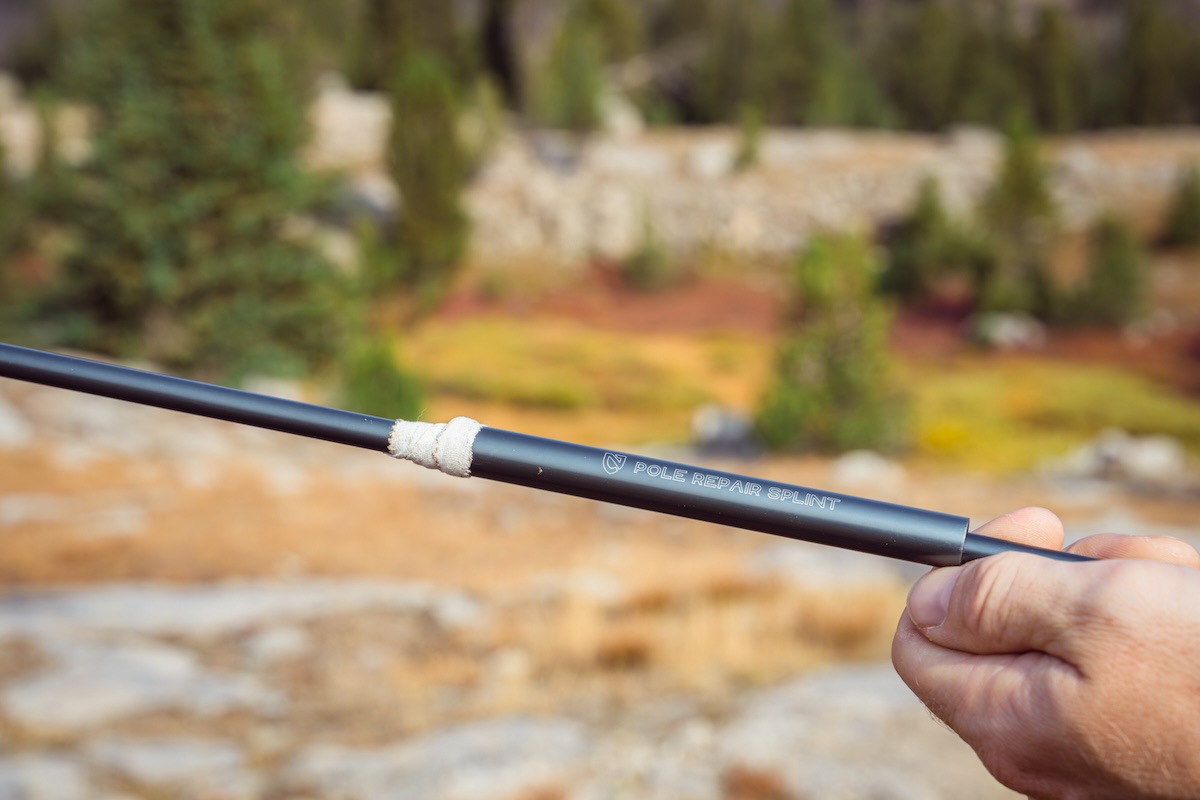
No matter the tent style or manufacturer, stakes are an integral part of setting up a tent. Most two-person tents will include six: one for each corner and one for each side of the vestibule. That’s all fine and good for setting up in mild conditions, but it’s insufficient for bad weather when you want to use guylines. Thus, you may want to purchase some extra stakes, and it could be worth replacing your stock ones as well. Cheaper hook-style aluminum stakes come with most tents and can be a pain to use because they’re too thick and round to easily sink into the ground, plus they have a tendency to bend when being hammered in. Thankfully, upgrading isn’t very expensive. We really like the MSR Groundhogs: They are light, tough, and easy to put in the ground. And the DAC stakes that come with the Hilleberg Nallo (and other Hilleberg models) are some of the best we've used.
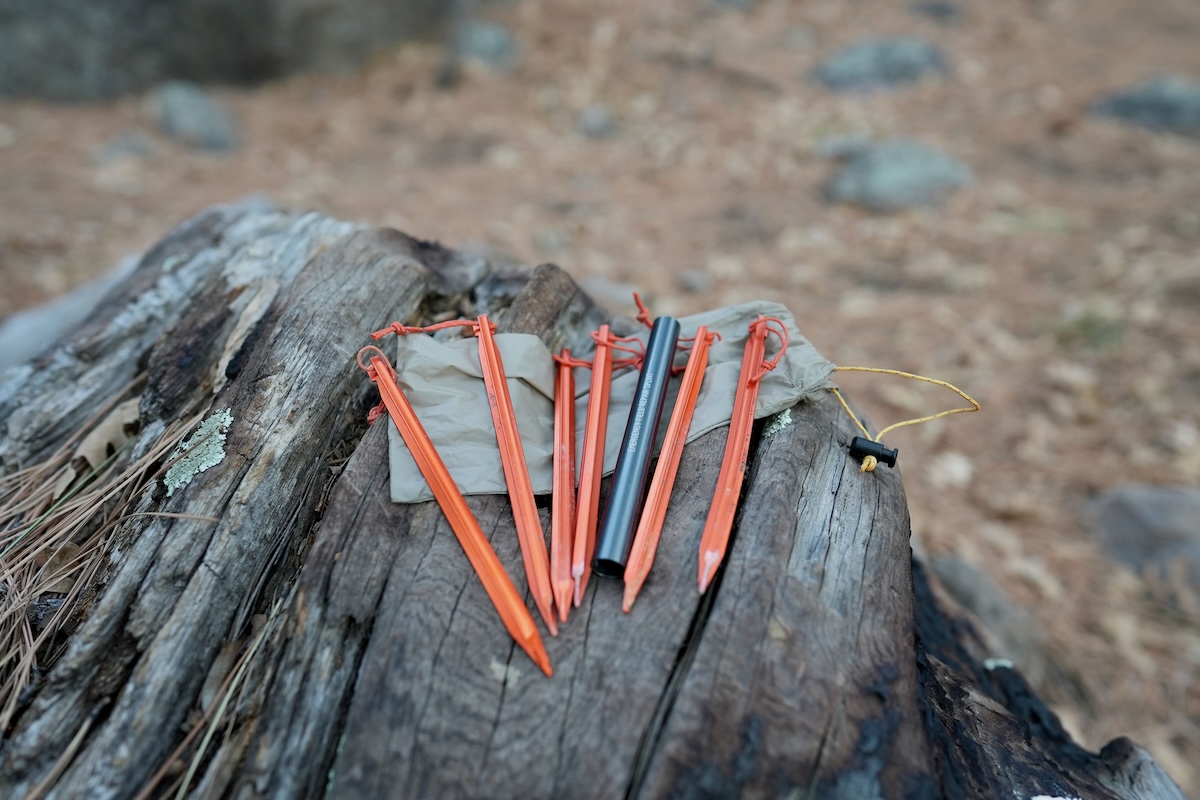
Most of the backpacking tents above are of the two-person variety, with floor plans that can accommodate two 20-inch sleeping pads side-by-side. The two-person tent is the most popular capacity, but many backpacking models also come in one-, three-, and four-person designs. Solo travelers can save some weight by opting for a one-person option, while families or couples traveling with a dog can bump up to a three- or four-person model. It almost goes without saying that weight and packed size will increase alongside capacity, but it is worth noting that, in general, one four-person tent will be lighter than two two-person models. For example, the Marmot Tungsten 4 checks in at 9 pounds 3.8 ounces, while the two-person version weighs 5 pounds 14.2 ounces.
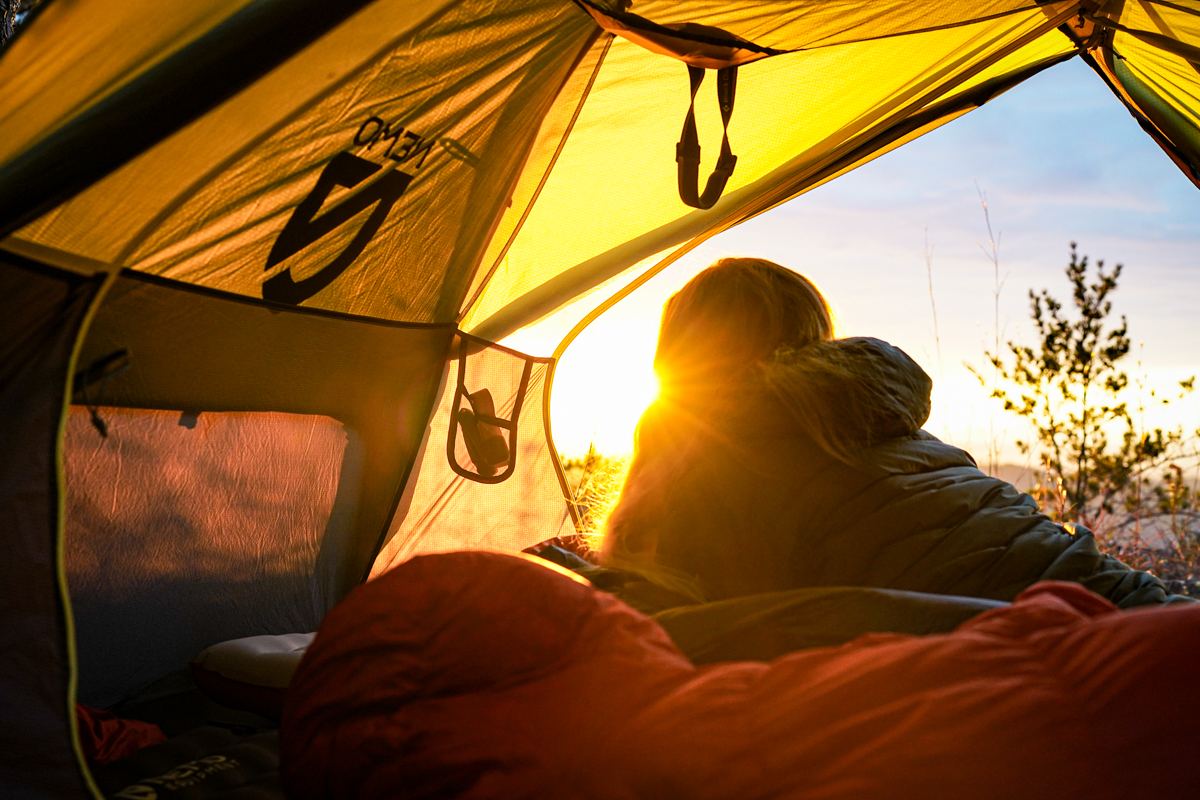
Sustainability is an increasingly important consideration for many consumers, and we’re happy to see several leading outdoor brands rising to the occasion. In 2024, the two most common sustainability measures we look for in backpacking tents are recycled fabrics and PFAS-free water-repellent coatings, the latter of which forgo harmful per- and polyfluoroalkyl substances—“forever chemicals” that are notorious for their inability to break down over time. From our list above, Nemo is a clear leader in the sustainability realm, with all of their included offerings—the Dagger, Hornet Elite, and Aurora—utilizing recycled materials and PFAS-free coatings. Big Agnes, MSR, and a couple others have also started employing solution-dyed fabrics in many of their tents, which use less energy and water consumption during production compared to standard dyeing practices.
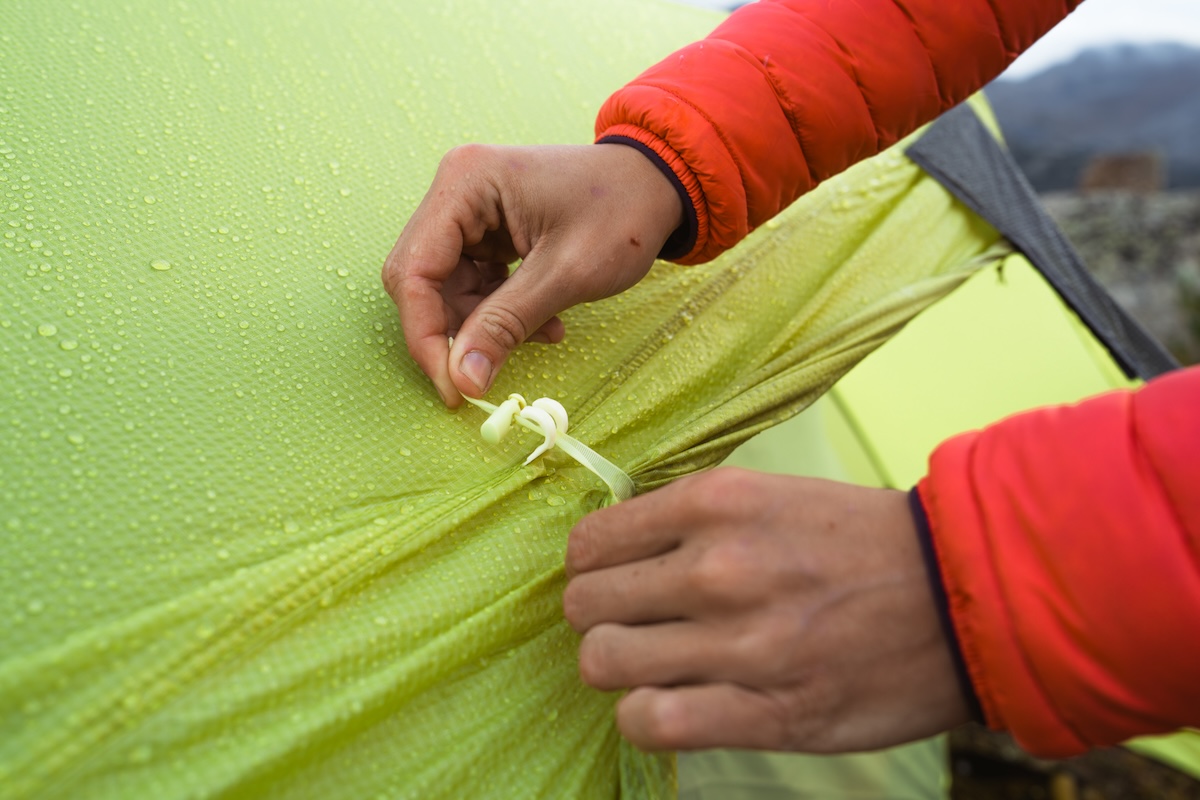
We’ll start by noting that a footprint is optional—some of the tents above come with an included footprint, while others do not. These simple tarps go beneath your tent (usually attaching to the pole in each corner) to provide an extra layer of protection underneath. They’re a nice added bit of assurance to have when it’s wet (make sure to tuck them under the tent to avoid pooling, as that can have the opposite effect) or when you’re camped on rough surfaces like granite or sharp plants. That said, they do add an additional cost (a $40 footprint would increase the price of a $200 tent by a whopping 20%) and 5 to 10 ounces to your pack.
Here’s our take: A footprint is a good idea if your tent is thin in terms of denier (see the durability section above) or if you plan on camping on rough surfaces like granite, tend to be careless with your gear, or don’t have the risk tolerance for a torn floor (and the subsequent repair). On the other hand, if you have a durable tent and are camping on dirt, it’s unlikely that your tent will rip.
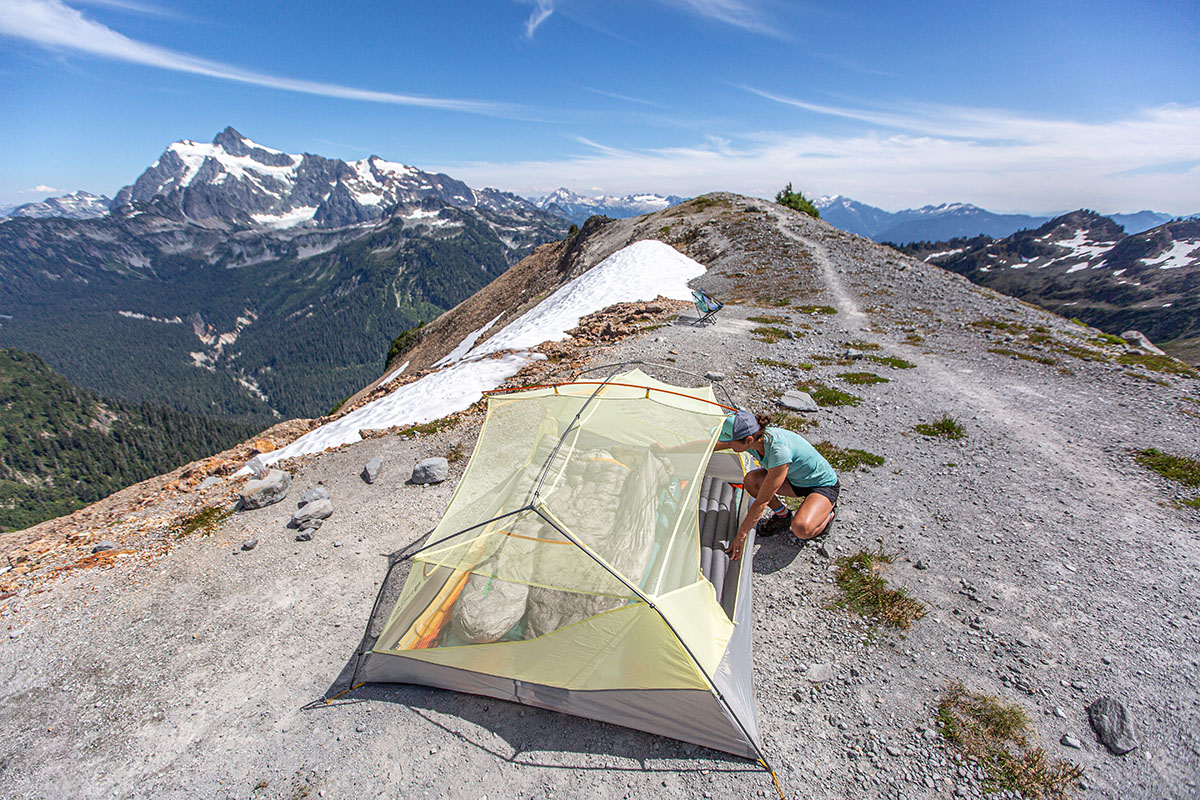
If you do choose to buy a footprint, you can usually get one specifically designed for your tent, pre-cut to the proper dimensions with grommets that attach to the tent poles directly. If your tent has a fast-pitch option, the footprint will complete the setup, allowing you to set up an ultralight shelter by adding your tent poles and rainfly. And for those who want to save money or weight, there are a number of DIY options, including grabbing a sheet of Polycryo or Tyvek from your local hardware store (or the dumpster near a construction site—as our dirtbag editor is known to do). For more information and to help you determine if a footprint is a necessary addition to your kit, see our article: Does Your Backpacking Tent Need a Footprint?
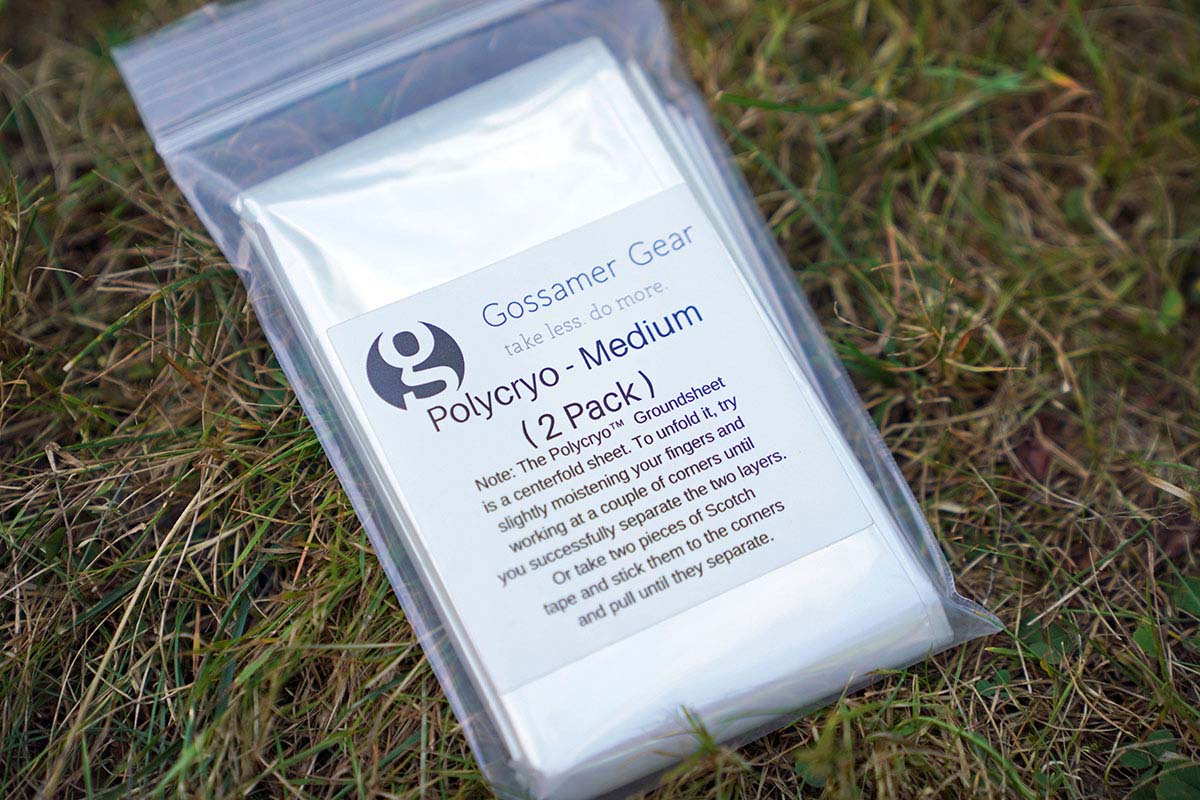
Cost always is a key consideration and a backpacking tent is a big purchase. Here’s our take: If you are on a budget, only plan on backpacking once or twice a summer, are covering short to moderate distances, or just don’t mind carrying a few extra pounds, we are big fans of entry-level tents like the REI Co-op Trail Hut 2 ($229 with a footprint included) and Half Dome 2 ($299 but a noticeable step up in interior space and features). These tents offer the highest value: Build quality is good, they are durable and roomy, setup is easy with simplified pole structures, and they cost considerably less than lighter-weight models. For casual backpackers on shorter trips, there is no need to spend more.
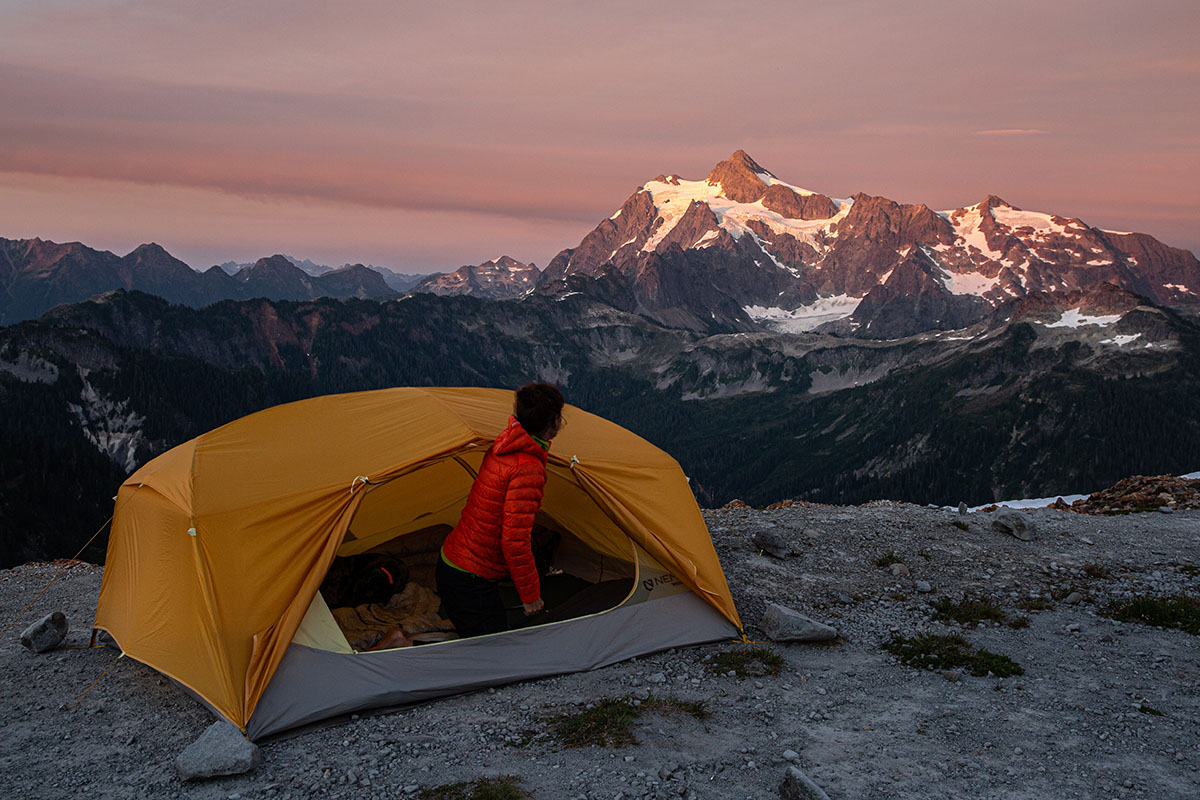
Continuing up the price ladder, the trend is toward lighter and more packable designs. For those who take multi-day backpacking trips, get out a lot, and prioritize a low pack weight, the investment will be well worth it. Tents that are lightweight yet fairly uncompromised will be some of the most expensive (consider the $550 Big Agnes Copper Spur), while semi-freestanding designs with smaller footprints will come in a bit less (the $400 Big Agnes Fly Creek, for example). Most people may not want to consider anything above $500, but this is where you’ll find the lightest designs and the most expensive materials, such as Dyneema fabrics and carbon fiber poles. These tents (like the $729 Zpacks Duplex Zip) are a good fit only for extremely weight-conscious backpackers and thru-hikers who spend countless nights outside and need the best tool for the job. However, unless you care a lot about saving weight, they’re often not the best value, with fragile materials and compromised livability and features.
Back to Our Top Backpacking Tent Picks Back to Our Backpacking Tent Comparison Table